Select person's name for the cars you want to view:
Will’s Cars
| Make & Model | Story | |
|---|---|---|
 |
Subaru Legacy Wagon | Will’s first car was a Subaru Legacy station wagon, a workhorse that doubled as his pizza delivery vehicle. It served him well for a time, hauling pizza boxes with ease and handling the demands of his job. However it developed a frustrating habit of overheating during deliveries. On more than one occasion, Will found himself forced to pull over and wait for the engine to cool down before he could deliver his next pizza. The overheating episodes eventually wore him down, leading him to part ways with his faithful but temperamental wagon. |
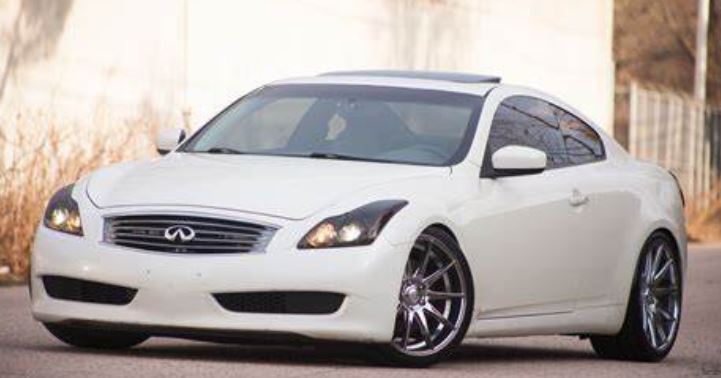 |
Infinity G37 | Will’s next car was a departure from his humble pizza-delivering days. Out went the weary, overheating Subaru Legacy, and in came a sleek, head-turning Infiniti G37. With its powerful V6 engine and smooth touring capabilities, this two-door beauty was built for spirited drives and effortless cruising. Its sporty, aerodynamic design made it look like it belonged on a poster—or at least in a much fancier neighborhood than Will’s pizza route. But while the car screamed “luxury,” it seemed nobody had considered the logistics of fitting a 6’7” driver into its cockpit. Will could squeeze in, sure—but driving the G37 felt more like performing yoga poses than enjoying a luxury ride. Knees up to the dashboard, head brushing the roof, and the seat jammed as far back as physics would allow, it was clear this car wasn’t designed with basketball players in mind. Still, for all its cramped quarters, the Infiniti looked great in the driveway. It just never got the chance to stretch its legs on the open road with a driver who could actually stretch his. |
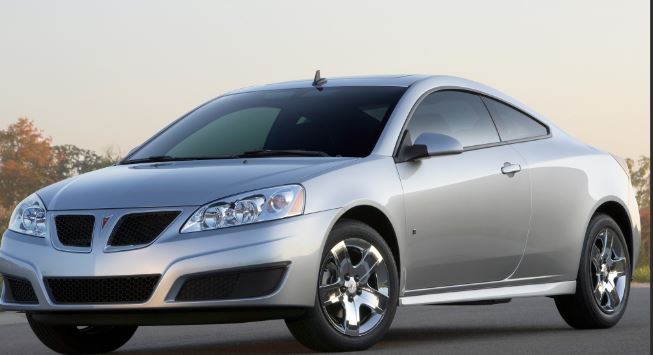 |
Pontiac G6 | Will’s next car was his first dive into the world of American engineering—a Pontiac G6. Sleek and stylish, the G6 was a solid car and a practical ride that still had some flair. Will enjoyed the car’s smooth handling and comfortable interior, making it a great all-around vehicle for daily drives. However, living in Utah meant dealing with winter’s icy grip, and the G6 wasn’t exactly built to conquer snowy driveways. After a few episodes of spinning wheels and shoveling himself out of his parents’ driveway, Will came to a realization: it was time to trade up to something with four-wheel drive. While the G6 served him well, Utah winters demanded a car that could do more than just look good—it had to perform in the snow, too. The search for his next car had a new requirement: it needed to laugh in the face of snowbanks. |
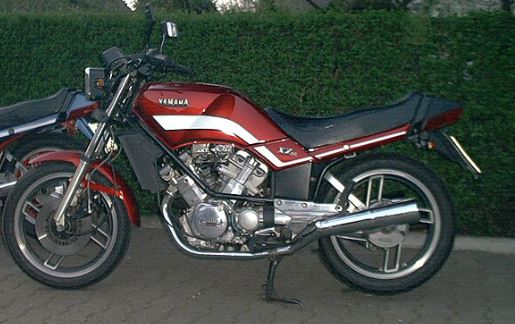 |
1985 Yamaha Maxim 550 | Will’s first motorcycle was a 1985 Yamaha Maxim 550, a classic ride that struck a balance between sporty performance and cruiser comfort. This mid-sized bike was part of Yamaha’s versatile XJ series, designed to appeal to riders who wanted a little bit of everything. With its nimble handling and reliable engine, the Maxim 550 was perfect for a first motorcycle. It offered enough power to make every ride exhilarating, without being too intimidating for someone just getting their feet wet in the world of two wheels. The bike’s retro styling, complete with a stepped seat and chrome accents, made it as much of a looker as it was a joy to ride. For Will, this Yamaha wasn’t just a motorcycle—it was the start of a lifelong love affair with the open road. |
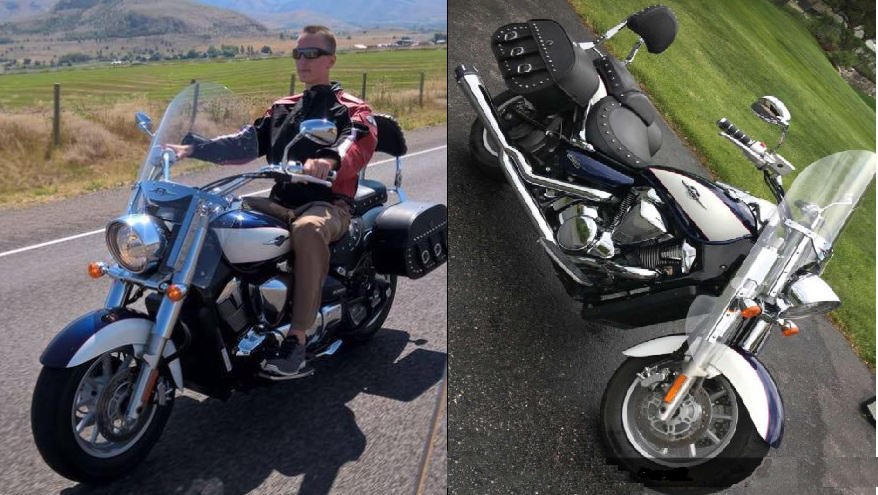 |
Suzuki Boulevard C90 | Will’s next two bikes were Suzuki Boulevards, a clear evolution from his Yamaha days and a step deeper into the cruiser world. In 2005, Suzuki revamped its cruiser lineup under the Boulevard series, introducing a host of improvements that made these bikes stand out. Gone were the carburetors of old, replaced with a modern multiport fuel injection system borrowed from Suzuki’s high-performance GSX line. This upgrade wasn’t just a technical tweak—it transformed the ride. The new fuel system, featuring dual throttle valves and an automatic fast idle system, delivered smoother starts, stronger torque, and quicker acceleration. Whether cruising through city streets or tackling long highway stretches, the Boulevards offered a blend of muscle and comfort that made them irresistible to Will. With their sleek design and enhanced performance, these bikes weren’t just rides—they were statements. For Will, the Boulevards embodied the perfect mix of power, reliability, and style, making them the ideal companions for his adventures on the open road. |
 |
2014 Ducati Diavel | The 2014 Ducati Diavel is a striking blend of sportbike performance and cruiser comfort, designed to stand out both in terms of aesthetics and power. At its heart is a 1,198.4cc Testastretta 11° L-Twin engine, delivering an impressive 162 horsepower and 96 lb-ft of torque. Paired with Ducati’s signature technology, including multiple riding modes, Ducati Traction Control (DTC), and ABS, the Diavel provides a customizable riding experience that caters to both spirited performance and relaxed cruising. Its lightweight tubular steel trellis frame, paired with top-tier Marzocchi and Sachs suspension, ensures agility and stability, even when pushing its limits. Visually, the 2014 Diavel turns heads with its aggressive, muscular design, highlighted by a wide 240mm rear tire and a sculpted fuel tank that flows seamlessly into the integrated tail section. Premium features such as LED lighting and a dual-screen instrumentation system add a modern touch, while the Carbon variant further elevates its appeal with lightweight carbon fiber components and forged wheels. Whether on urban streets or open highways, the Diavel’s unique combination of power, comfort, and style makes it a standout choice for riders seeking a performance-oriented cruiser with Ducati’s Italian craftsmanship. |
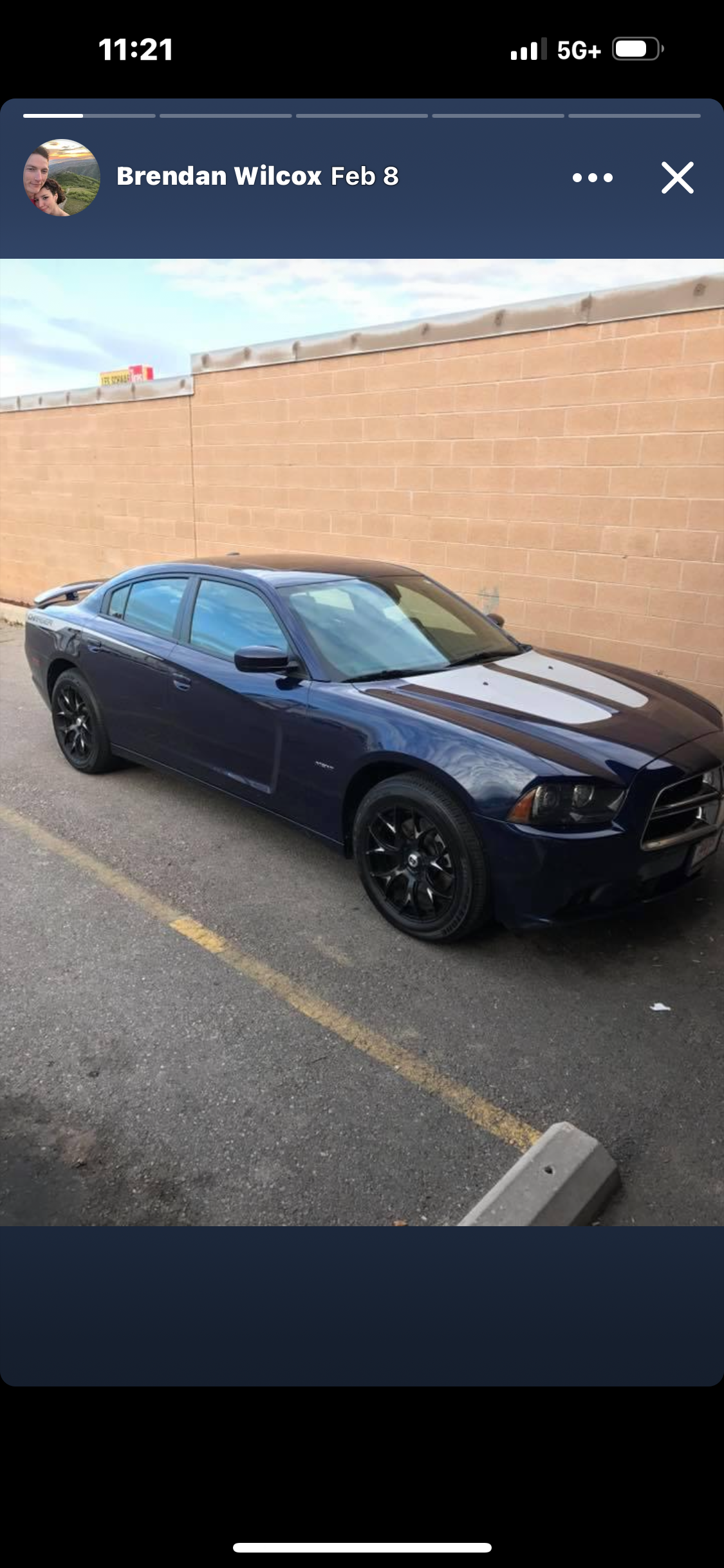 |
2011 Charger | The 2006 Dodge Charger marked the return of the iconic Charger nameplate, reimagined as a bold, full-size four-door sedan rather than the two-door muscle car of its 1960s and 1970s heyday. Built on the Chrysler LX platform, the Charger combined retro-inspired styling cues with modern performance and practicality. Its aggressive stance, muscular fender lines, and crosshair grille gave it a commanding presence on the road. Available trims included the base SE, sporty R/T, and high-performance SRT8, each catering to a different level of driver enthusiasm. The SE featured a 3.5-liter V6 engine, while the R/T brought a 5.7-liter HEMI V8 with 340 horsepower. For those craving extreme power, the SRT8 delivered 425 horsepower from its 6.1-liter HEMI V8, ensuring it could compete with other modern muscle cars. The Charger’s interior offered a mix of functionality and comfort, with options like leather upholstery, a premium sound system, and a navigation system for a touch of luxury. While some critics noted the interior’s design and materials felt somewhat dated, the focus remained on performance and versatility. The 2006 Charger gained praise for its precise handling, strong acceleration, and smooth ride, making it suitable for both daily commutes and spirited driving. It also catered to a wide audience by blending modern family sedan practicality with the nostalgia and performance of a classic muscle car, establishing its place as a unique entry in Dodge’s lineup. |
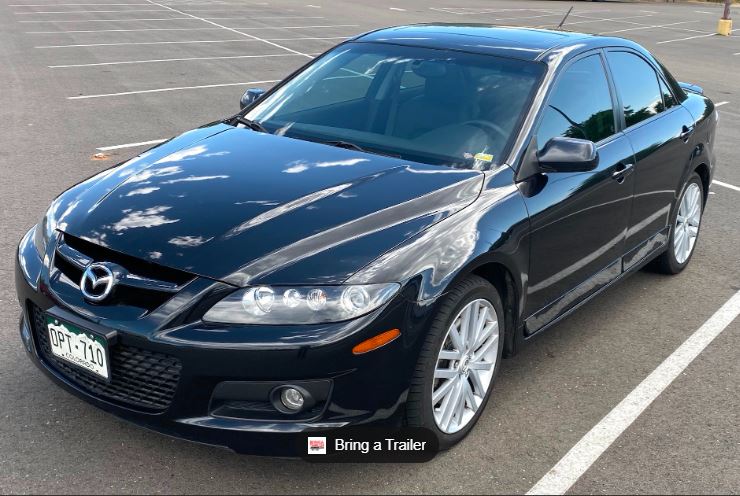 |
Mazdaspeed6 | Will’s next car was a Mazdaspeed6, a machine that checked all the boxes for his Utah lifestyle—sporty performance and all-wheel drive. Powered by a turbocharged 2.3L engine, this car wasn’t just a commuter; it was a rocket on wheels. The all-wheel-drive system gave it the grip needed to handle snowy roads with confidence, finally solving the winter conundrum that had plagued his previous rides. But let’s be honest, it wasn’t just about conquering snowbanks. For Will, the Mazdaspeed6 offered something his other cars hadn’t: speed. Lots of it. The thrill of driving this turbocharged beast made every errand feel like a rally stage. Whether carving through canyon roads or cruising through town, this car perfectly balanced practicality and excitement. For Will, it was a dream come true—a car that could handle the snow and satisfy his need for speed. |
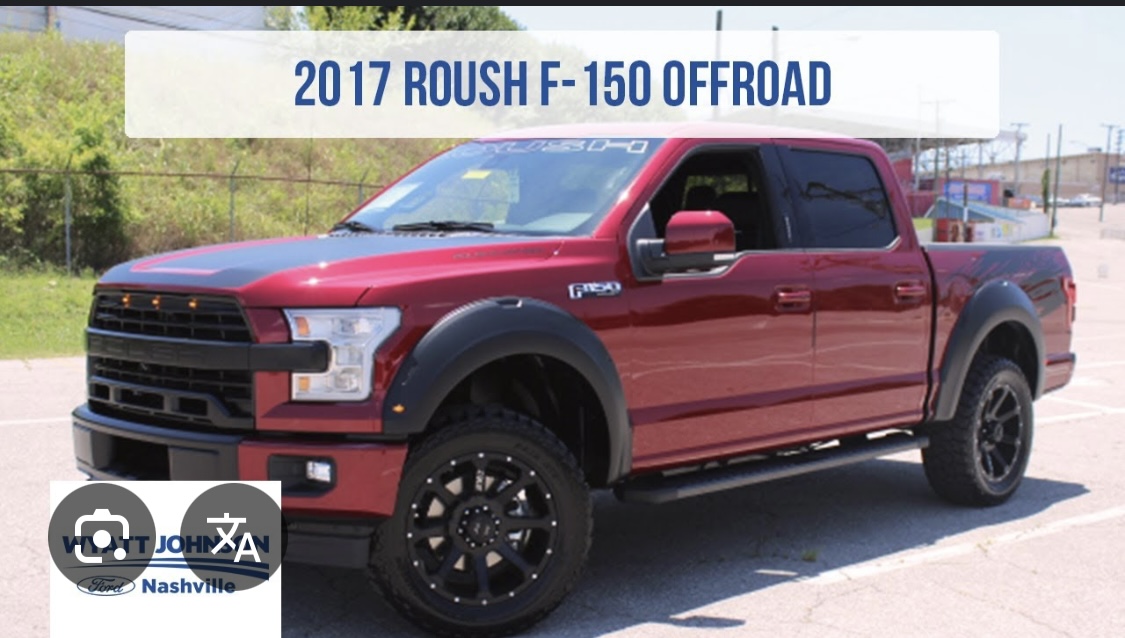 |
2017 Ford F-150 Roush | The 2017 Ford F-150 Roush is a high-performance version of the iconic F-150, blending rugged capability with striking styling and upgraded power. Built on the sturdy platform of the F-150, Roush takes this truck to the next level with aggressive design elements, off-road enhancements, and optional performance upgrades. The standout feature of the Roush edition is its 2.0-liter TVS Roush supercharger, available on the 5.0-liter V8 engine, which boosts output to an impressive 600+ horsepower and 557 lb-ft of torque. Paired with a six-speed automatic transmission, the Roush F-150 delivers thrilling acceleration and seamless performance whether on the highway or off-road. The suspension is also upgraded with Roush-tuned Fox 2.0 shocks, providing exceptional off-road handling and ride quality. The exterior of the 2017 F-150 Roush is enhanced with bold styling cues, including a custom Roush grille, aggressive fender flares, unique graphics, and dual-tip exhausts for a commanding presence. The truck rides on 20-inch Roush wheels wrapped in all-terrain tires, ready to tackle rugged terrains with confidence. Inside, the cabin retains the practicality and comfort of the F-150 but features optional Roush touches such as custom badging, embroidered headrests, and upgraded materials. With its perfect combination of raw power, off-road capability, and head-turning style, the 2017 Ford F-150 Roush is a thrilling option for truck enthusiasts looking for performance and versatility in a bold package. |
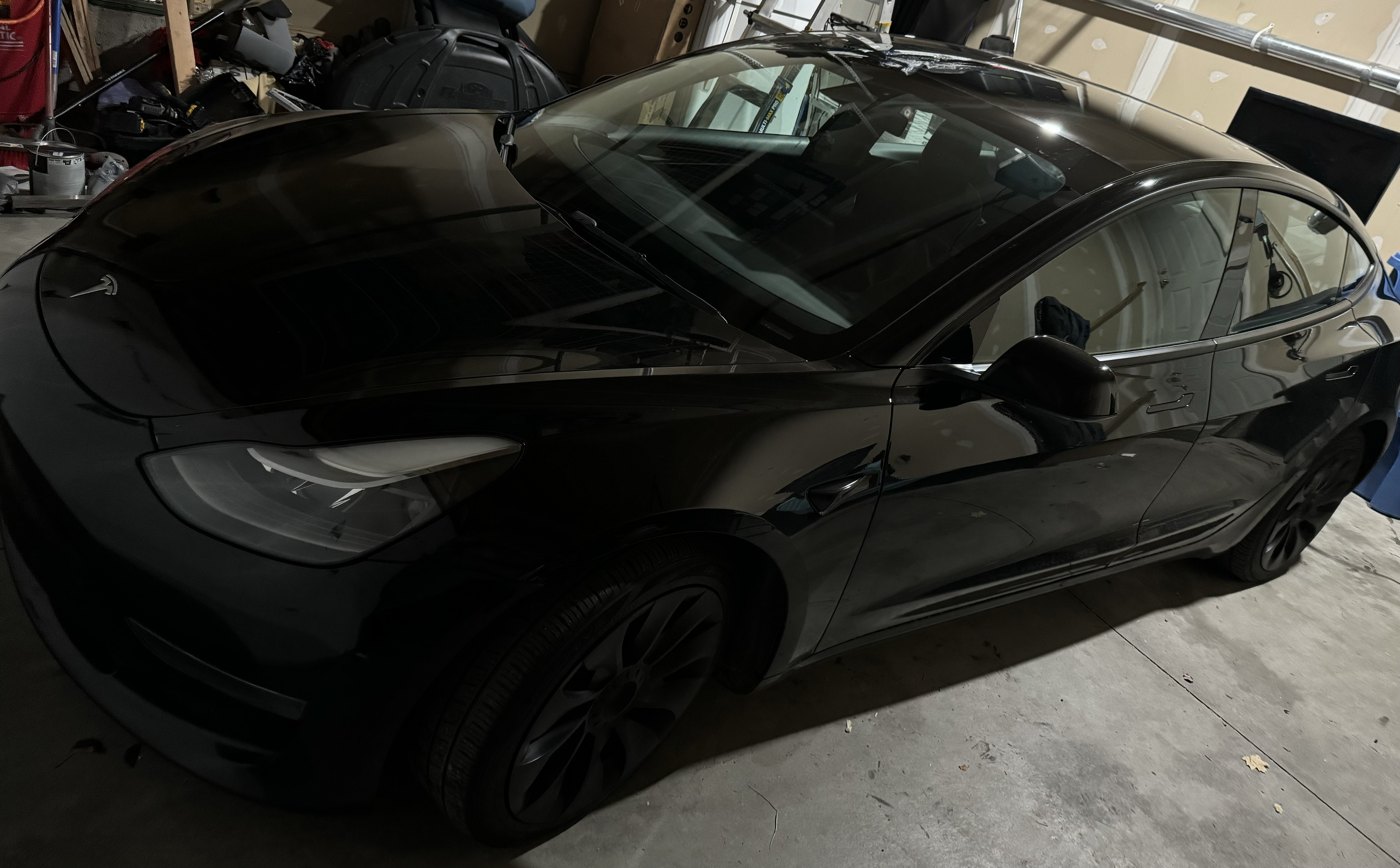 |
2022 Model 3 | The 2022 Tesla Model 3 Long Range is a standout electric sedan designed for drivers seeking a balance between extended driving range, performance, and cutting-edge technology. It boasts an EPA-estimated range of up to 358 miles on a single charge, making it one of the most efficient electric vehicles in its class. Powered by a dual-motor all-wheel-drive system, the Long Range trim delivers exceptional traction and stability, with a 0-60 mph acceleration time of just 4.2 seconds. The minimalist cabin is dominated by a 15-inch touchscreen that controls nearly all vehicle functions, offering seamless access to navigation, media, and climate settings. Tesla’s over-the-air software updates ensure the car stays at the forefront of innovation, continually adding new features and enhancements. Beyond performance and range, the Model 3 Long Range excels in safety and technology. It includes Tesla’s Autopilot system, which features advanced driver-assistance tools such as adaptive cruise control and lane centering. The premium interior includes heated seats, a premium audio system, and an expansive glass roof that enhances the sense of space. With access to Tesla’s extensive Supercharger network, long-distance travel is convenient and worry-free. The 2022 Model 3 Long Range is an ideal choice for those seeking a practical, eco-friendly vehicle without sacrificing luxury or driving dynamics. |
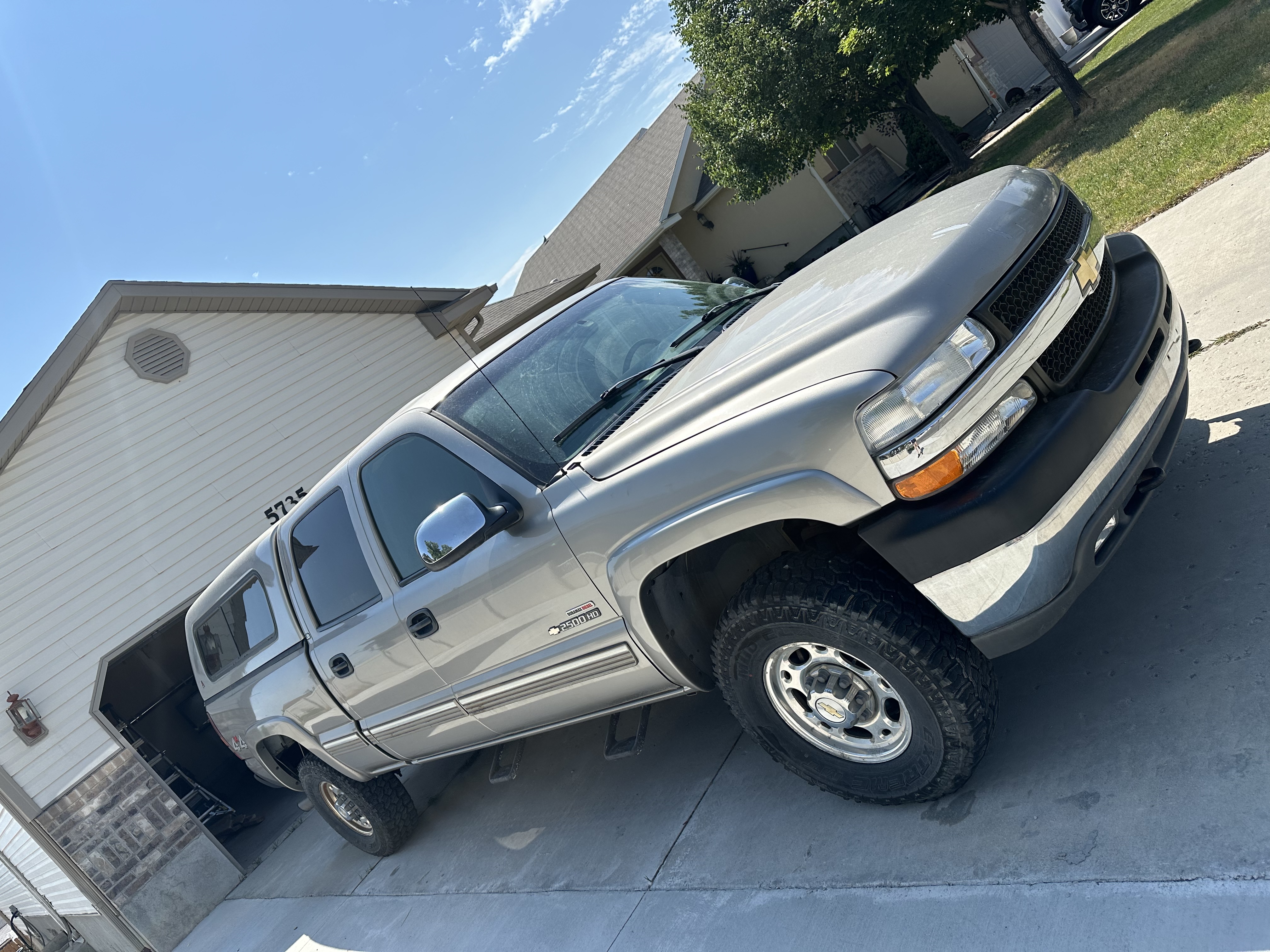 |
2002 Chevrolet HD2500 | The 2002 Chevrolet Silverado 2500HD Duramax is a heavy-duty pickup truck that combines robust engineering with the power of the legendary 6.6-liter Duramax V8 turbodiesel engine. This engine produces 300 horsepower and an impressive 520 lb-ft of torque, making it ideal for heavy towing and hauling. Paired with the highly-regarded Allison 5-speed automatic transmission, the Duramax-powered 2500HD delivers smooth performance, excellent durability, and efficient power delivery for demanding workloads. With a towing capacity of up to 12,000 pounds and a payload capacity exceeding 3,000 pounds, the 2500HD Duramax is built to handle the toughest jobs with ease. Its rugged chassis and available four-wheel-drive system further enhance its capability, making it a reliable choice for both work and off-road adventures. Inside, the 2500HD Duramax offers a practical and comfortable cabin with features tailored to both utility and convenience. Depending on the trim level, it can include power-adjustable seating, dual-zone climate control, and an upgraded audio system, ensuring a comfortable driving experience even on long trips. The interior is designed with durability in mind, while higher trims provide a touch of refinement for those seeking more luxury. With its blend of power, durability, and functionality, the 2002 Chevrolet Silverado 2500HD Duramax stands out as a dependable and versatile truck for those who need serious performance without sacrificing comfort. |
Ed's Cars
| Make & Model | Story | |
|---|---|---|
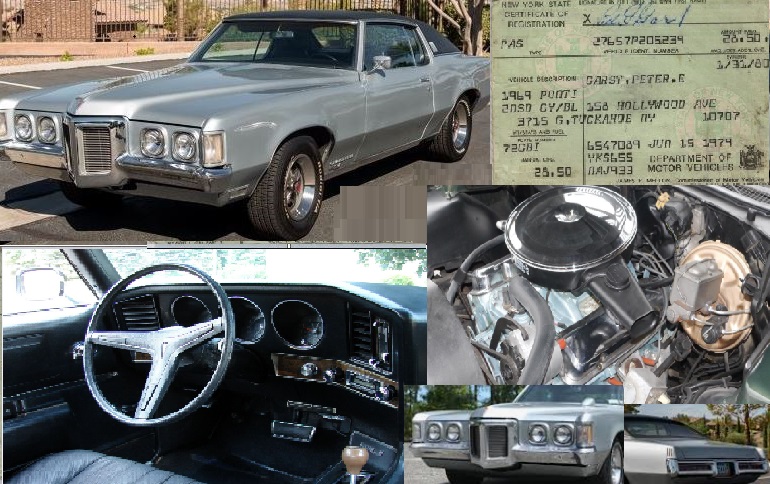 |
1969 Pontiac Grand Prix Model J | The car was originally purchased from a nurse who worked with Grandma Nancy. Pete bought it for around $600—a steal for what it was. Under the hood, it had a roaring 400-cubic-inch V8 engine paired with a four-barrel carburetor. It was an absolute blast to drive, a true blend of luxury and muscle. That car more than made up for the infamous 1963 Corvette fiasco, which, much to Pete’s chagrin, turned out to be a Corvair. When Pete left to work at Gurney’s Inn, the car was left behind. Ed struck a deal with Pete: if Ed could get the car running again, they’d split ownership. For two months, Ed toiled with the old Mobil/Exxon station in Tuckahoe. Eventually, the beast roared back to life, and it was back on the road. But life with the car was always an adventure. After one of Pete’s escapades on Long Island, it returned battered and bruised—filled with beer cans, littered with parking tickets, and suffering from broken shocks and ball joints. It was clear the car needed a more stable steward, so Ed decided to buy Pete out. Dot surely remembers one of the car’s most harrowing moments. It was a snowy afternoon, and she was heading home from high school. Against better judgment, she decided to take Colonial Parkway—a treacherous, steep hill. With snow piling up, the 4,000-pound beast on Firestone 500 slicks was hardly up for the task. Even crawling along at 5 mph, using the curb as a guide, the car skidded, hopped the curb, and collided with a telephone pole. The front end was completely redesigned by the encounter. And then there was the infamous runaway incident. One day, Ed went to pick up a friend. As he walked away, the parking brake cable snapped. The car rolled out of the driveway, narrowly missing two elderly folks sitting in rocking chairs on a patio across the street. Fate—or luck—intervened, and disaster was avoided, but not without leaving a story to tell. | 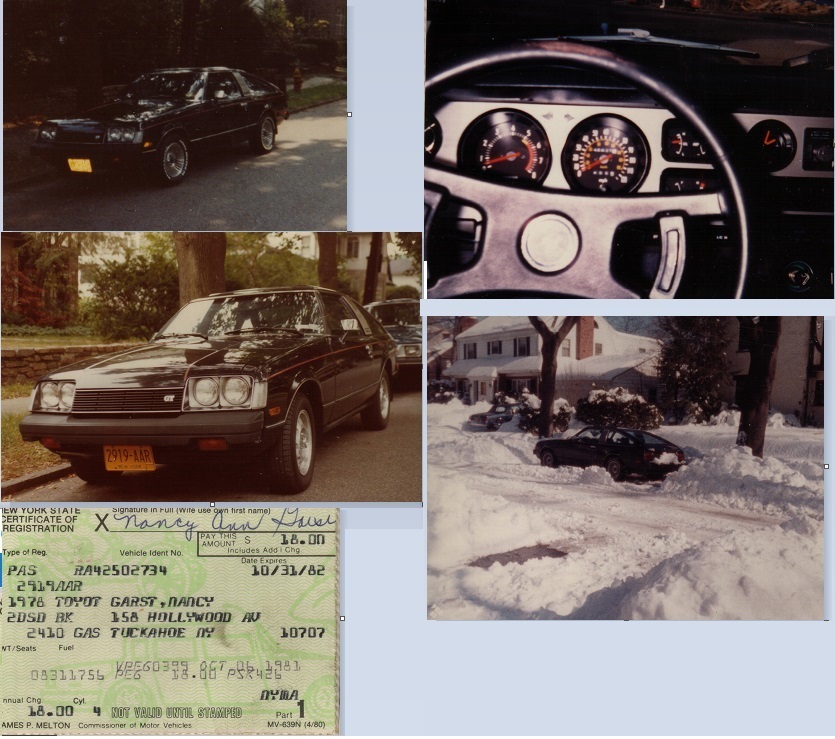 |
1978 Toyota Celica GT Liftback | The car was purchased from Crabtree Toyota in New Rochelle, but it wasn’t exactly the car Ed had originally set his sights on. He had saved up $6,500 to buy his dream car—a sleek Datsun 280Z. However, after a little fatherly guidance, he drove home in something more practical: a 1978 Toyota Celica. It wasn’t the 280Z, but it was still an incredible car. As the Motor Trend Import Car of the Year, it offered style, reliability, and practicality—and it was much friendlier on gas and insurance. Plus, it came with a five-speed manual transmission and a sunroof, which gave it just the right touch of sportiness. Ed remembers taking it out for its first spin through Tuckahoe with his friend Jimmy Secor. The excitement of owning a new car was slightly overshadowed by a memorable moment at a red light on a steep hill. Navigating the tricky incline with his new manual, Ed unintentionally left a symphony of honking cars in his wake—a rite of passage for any new stick-shift driver. The Celica served him well during its time, but when Ed decided to move to Florida, it was time to let it go. The car found a new home with Joe McGarry, and while Ed moved on, the memories of that Celica and the adventures it sparked stayed with him. |
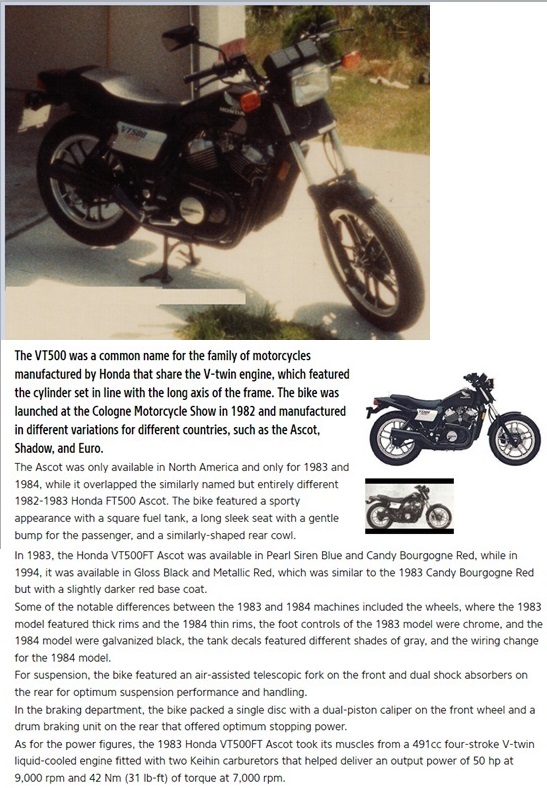 |
1983 Honda Ascot VT 500 | Ed bought the motorcycle to tackle the grueling 150-mile trip on Route 60 between Vero Beach and Tampa—a nightmare of a journey, but necessary for getting back and forth to college. It wasn’t long before the bike gave him his first real lesson in caution. In his first week of ownership, he was riding back from the Jungle Club on US 1. Feeling adventurous, Ed decided to open it up on a long, empty stretch of road. The speedometer climbed past 100 mph, the wind rushing by—but then, out of nowhere, a slow-moving lawn tractor appeared, crossing the highway directly in his path. Ed’s heart nearly stopped as he narrowly avoided the tractor and its spinning rear blades. It was a wake-up call he wouldn’t soon forget, and from that day forward, Ed learned to ride with much more respect for the road. Another memorable story came that summer, while Ed was away upstate selling books. He decided to teach his dad how to ride the bike before he left. After giving a brief overview of the clutch, brakes, and accelerator, Ed handed over the controls. At first, Dad took it slow, rolling down the street with cautious confidence. But things took a dramatic turn—literally—when Dad tried to navigate the curve to come back. Confusing the accelerator with the brake, he unintentionally gunned the engine, sending the bike spinning around with a screech. In a blur, Dad raced back down the street, miraculously coming to a stop right in front of the house. Without a word, Dad calmly handed the motorcycle back to Ed, set the helmet on the seat, and walked into the house. That was the last Ed heard from him about the bike. In fact, Dad didn’t say another word for the rest of the evening. When Ed finally returned home at the end of the summer, the bike had one more surprise waiting for him: a dead battery that needed recharging. But despite its quirks—and the unforgettable adventures it sparked—that motorcycle remained a key part of Ed’s college journey. This version keeps the details but brings more structure, pacing, and descriptive flair to make the story engaging while retaining its humor and heart. |
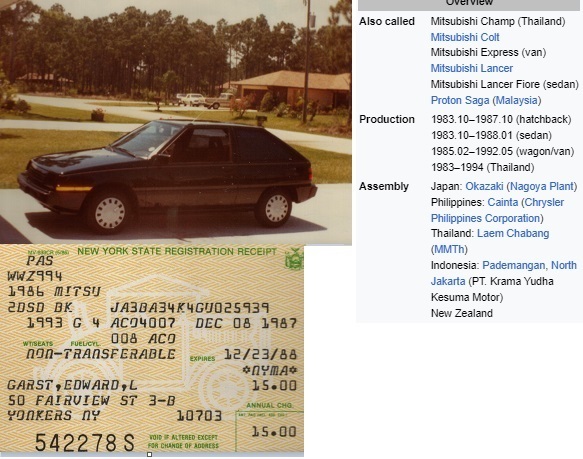 |
1984 Mitsubishi Mirage | Ed bought this car from Superior Mitsubishi while working at Courtesy Lincoln-Mercury. Despite being in the car business, he wasn’t entirely sure if he’d gotten a good deal. Still, the car served its purpose, reliably getting him to and from work and even making the long trek from Florida to New York during his move. But this car’s life was anything but uneventful. The first incident happened while Ed was waiting patiently at a red light. Out of nowhere, another car slid into the front end, causing damage that would take nearly a month to repair. Frustrating, but manageable. Then came the second mishap, which was far more puzzling. After taking the train into Manhattan for work, Ed returned to find his car missing. Assuming it had been stolen, he went straight to the police. However, after some investigation, it turned out the car had been sideswiped by a truck while parked on the side of the road. The third incident was the most dramatic of all. After a late night in the city playing volleyball and socializing with friends, Ed came back to where he’d parked, only to discover the car was gone—again. Back to the police department he went, only to be told there was no record of the vehicle. Frustrated and confused, Ed walked to train station the following Monday, only to stumble upon the car. It was sitting on the side of the road, completely demolished, a sad shell of its former self. Despite all the chaos surrounding it, that car certainly left its mark—literally and figuratively—on Ed’s life, becoming an unforgettable chapter in his story. |
 |
1989 Honda CRX Si | Ed can still remember the day he first laid eyes on the 1989 Honda CRX Si sitting next to the SR71 Blackbird in a magazine advertisement. Ed leased this from Bronx Honda, his first time leasing. This wasn’t just a car—it was a two-seat pocket rocket, an engineering marvel packed with horsepower that defied its size. The mag wheels sparkled, the sunroof begged to be opened on summer drives, and the thought of its smooth five-speed manual transmission. The little CRX was the car he picked up his new girlfriend Doreen in for countless dates, the one that carried them to their favorite pizza spot and late-night drives. But life moved forward. After their wedding, Ed realized he didn’t need the little sports car anymore. Practicality called for something different, something more suited to a new chapter. With a heavy heart, he arranged for someone else to take over the lease. |
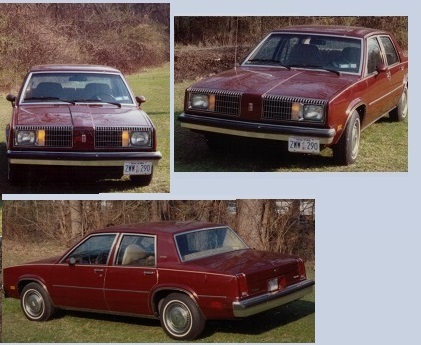 |
1981 Oldsmobile Omega | Doreen purchased her first car, a 1981 Oldsmobile Omega, after spotting it while driving home from the train station in Harrison. The car was basic transportation, reliably taking her to the train station each morning and carrying us to countless events. However, it had its quirks, especially the sagging headliner, which Doreen tried fixing with spray glue and tape before resorting to a stapler. Despite its flaws, the Omega became an essential part of our lives, embodying Doreen’s determination and resourcefulness. |
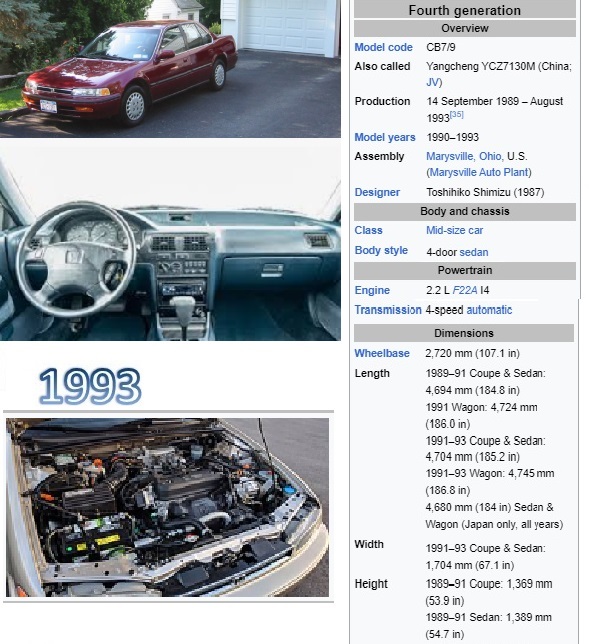 |
1993 Honda Accord EX | The 1993 Honda EX four-door wasn’t just a car—it was a part of your family’s story. We bought it brand new from White Plains Honda, drawn in by a Saturday paper ad and a fantastic deal at $14,995. It was a milestone purchase, marking the start of a new chapter as you prepared to welcome your first daughter. The EX delivered exactly what we needed: reliability, outstanding gas mileage, and value that stretched far beyond its sticker price. It carried our growing family through years of memories, from late-night diaper runs to road trips filled with giggles in the back seat. Always dependable, it became more than just transportation; it was a trusted companion during life’s early adventures. Eventually, as our family expanded, we had to move on to something larger, but that 1993 Honda EX left behind a legacy of firsts—a first new family car, first family road trips, and a symbol of the journey you began together. One funny story was when Ed was going to the dry cleaners and Stephanie, at 18 months old, took the electronic car keys out of my mouth while Ed was putting her in her car seat. After securing her in the car seat and while Ed was going to the driver’s door Stephanie hit the button and looked all the doors. This left me locked out of the car with her inside. It took multiple attempts to communicate with her and get her to press the button to unlock the door. After about 20 nerve-wracking minutes, she finally pressed the right button, unlocking the car and resolving the stressful situation. |
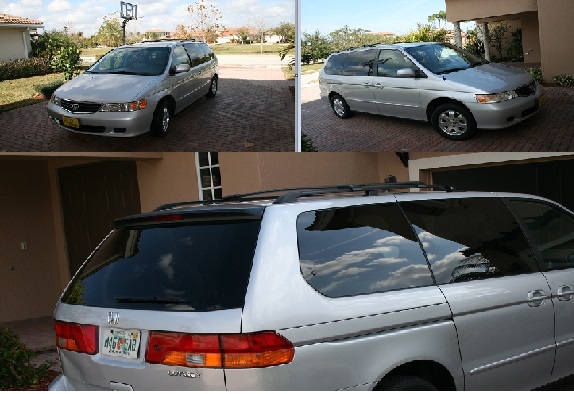 |
2002 Honda Odyssey EX | We always knew the Honda Odyssey EX was the gold standard for minivans, but we held off until the price markups came down. Finally, in 2002, we bought one home from Yonkers Honda, and it wasn’t long before she became part of the family. We named her Betsy. She wasn’t just a minivan—she was a living room on wheels. With the most comfortable captain’s chairs you could ask for, Betsy carried us on countless road trips to Florida, Maryland, Connecticut, and everywhere in between. She turned long drives into memorable family adventures, complete with movies and TV shows. Some of the best times were spent watching episodes of Friends together as we cruised along. My wife absolutely adored that car and still talks about her fondly to this day. For 12 years, Betsy was a reliable workhorse. She hauled kids to countless sports practices and games, moved furniture and supplies from Home Depot, and transported everything else we threw at her. Remarkably, in all those years, she only had one issue, which Ed fixed himself for just $80—a testament to her dependability. Eventually, though, Betsy started to show her age, and we knew it was time to let her go. Parting with her wasn’t easy, but we were grateful for the countless memories she gave us. Even now, years later, Betsy remains a beloved chapter in our family’s story, proving that sometimes a car isn’t just a car—it’s part of the family. |
 |
1992 Acura Legend 2dr | The 1992 Acura Legend two-door was nothing short of an amazing car. With the same engine as the NSX, it was both powerful and incredibly smooth—a true blend of performance and luxury. What Ed loved most was how the dashboard wrapped around the driver, giving me that cockpit-like feeling Ed hadn’t experienced since the 1969 Pontiac Grand Prix. It was a car that felt special every time you sat behind the wheel. When Ed bought it, the car was already 15 years old, but it had been meticulously cared for. In fact, it only had about 15,000 miles on it. Ed will never forget the moment he drove it away—the original owner, clearly attached to the car, looked like they might cry as Ed pulled out of the driveway. That just showed how much this car meant to people who truly appreciated it. As incredible as the Acura Legend was, practicality eventually won out. Gas prices were climbing through the roof at the time, and the Legend, being a premium-unleaded machine, wasn’t the most economical choice. Add in the fact that Ed was constantly shuttling kids to football and basketball practices, getting the car dirty and worn, and it didn’t feel right to keep it. It was too beautiful and too well-engineered to suffer through that kind of treatment. Ed decided to let it go; hoping someone else could appreciate and enjoy it as much as Ed did. Even now, Ed looks back fondly on that car. It wasn’t just a vehicle—it was an experience, a reminder of the days when cars were crafted with soul and purpose. |
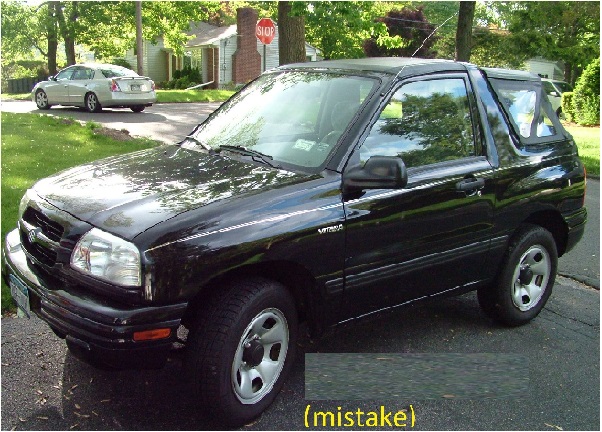 |
2001 Suzuki Vitara | The worst mistake Ed ever made was buying the 2001 Suzuki Vitara. Ed thought it would be a great car for handling the snow, but he completely overlooked a crucial detail—it was only 2-wheel drive. That alone was disappointing, but the real frustration came from the constant ignition issues. Getting them fixed was a nightmare, and being stranded because of it was beyond aggravating. Looking back, it was easily one of my worst decisions: bad judgment, bad car. What made the whole experience even more surreal was the day Ed went to see the car before buying it. The seller lived in a massive mansion in Harrison, complete with metal gates that had to open to let me in. The place was impressive—he even ran two Boar’s Head routes. Ed remembers thinking how surprising it was that someone so wealthy would even have a car like that. It felt like a mismatch from the start, but for whatever reason, Ed went ahead with the purchase. Years later, Ed still shakes his head when he thinks about that Vitara. It was a perfect storm of poor choices and bad luck, and it stands out as a lesson he’ll never forget. |
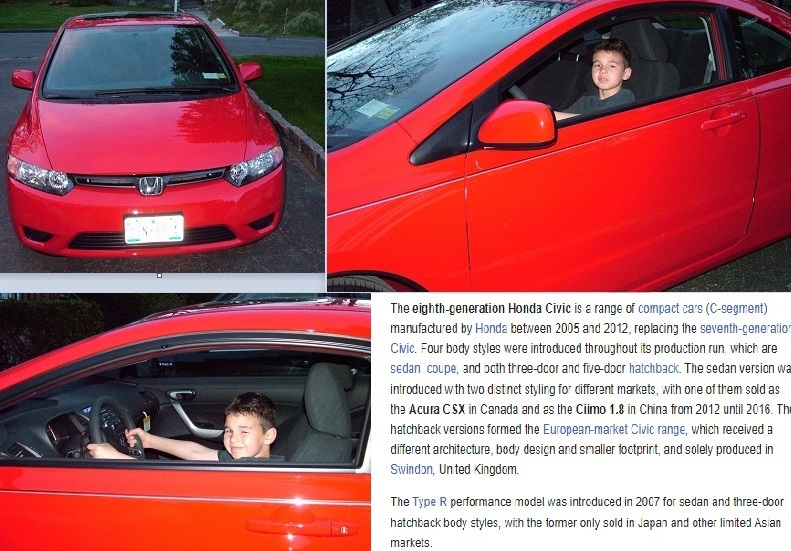 |
2006 Honda Civic Ex 2dr | The 2006 Honda Civic EX was a big step up from its predecessors. With its redesigned look and improved styling, it felt modern and sharp—much better looking than the older Civics. It was also an economical car, reliable with just enough features to make it practical but enjoyable. Ed was able to get it thanks to a $2,000 bonus from work, which came with my move from the home office in New York City to Tarrytown. The Civic served me well for several years, but it wasn’t without its adventures. Steph borrowed it for one semester at UCF, and that’s where things took a turn. One day, while she and Alex were driving, some guy—probably too busy smoking weed to pay attention—smacked into the car. It was never quite the same after that. The last big memory Ed had with that car was driving it from New York to Florida in 2008 for my new job at FPL. It was a grueling 18-hour drive, and what made it worse was a knot in one of the tires. The entire way down, all Ed could hear was a relentless womp, womp, womp. For 18 hours, that sound drove me absolutely crazy, but the car got me there, as dependable as ever. The Civic may not have had the most glamorous story, but it was a solid companion for those years—a true workhorse that managed to leave its mark, even if sometimes it was through frustration. |
 |
1975 Chevrolet Corvette Stingray | Stephanie and Ed made the trip to Coral Springs on Florida’s West Coast, renting a U-Haul truck and trailer to haul back 1975 Vette. Both of us took turns driving, and the journey itself was an adventure, filled with equal parts excitement and uncertainty. The original plan was ambitious: we hoped that Stephanie, Eric and Ed would able restore the car, turning it into a family project. Unfortunately, that never came to pass. Eventually, we began investing in it, redoing the suspension, replacing the front and rear lights, and making small improvements. However, as time went on, Ed began to research the car more thoroughly and discovered a crucial detail Ed had overlooked—the 1975 Corvette came with one of the weakest V8 engines Chevrolet ever produced. The 350-cubic-inch engine delivered less than 120 horsepower, less than my 2006 Honda Civic! Instead of putting endless time and money into restoring a disappointing model, Ed realized it would’ve been far smarter to simply buy a new Corvette. Ed had always hoped that Doreen and Stephanie would call the TV show "Restoration Garage" for help, but work, school, sports and life would interfere. |
 |
2016 Chevrolet Corvette LT1 EX | The 2016 Corvette LT1 was nothing short of a dream car. Ed still remembers the first time he saw renderings of it—it looked like something straight out of a superhero movie. That sleek, futuristic design, the long front end, the wide rear, and those insanely wide tires—it was like a modern-day Batmobile. Ed knew from the moment he saw it that he had to have one. Ed saved every penny he could, and thanks to a lucky investment at work that doubled in value, Ed finally made the dream a reality. The day he bought it was unforgettable. This car wasn’t just fast—it was supercar fast. Driving it was a visceral experience, especially on Old Dixie Highway. I’ll never forget cruising at over 105 mph one morning, feeling the raw power of that engine. It was like nothing I’d ever experienced—a rush of adrenaline and pure exhilaration. One time, Ed took a coworker out for a quick spin to show off what the car could do. We eased into a turn and then hit the gas. The power was so immense that Ed almost lost control of the car. The look on my coworker’s face said it all—Ed thought he nearly peed his pants. It was a reminder of just how much car Ed was handling. Despite how incredible it was, the Corvette LT wasn’t without its quirks. Being a seven-speed manual, it wasn’t exactly practical for everyday driving. Ed also ran into some frustrating issues with the electronic dashboard—it would randomly go out, forcing me to restart the car a few times to get it back. That’s when Ed knew it was time to make a decision. With the release of the new C8 Corvette on the horizon and resale values about to drop, Ed decided to sell it. Little did Ed know, Covid would send car prices skyrocketing shortly after? Even though it was a relatively short chapter, the 2016 Corvette LT left an unforgettable impression. It was a car that defined what it meant to have pure, unfiltered driving excitement. I’ll always remember it as one of the most thrilling rides of my life. |
 |
2018 Kia Stinger | To say that Doreen was upset when Ed sold the Corvette would be an understatement. She made it very clear: the next car couldn’t be a “clown car” and had to be something nice. So, we set out together to find the right replacement. Surprisingly, we both agreed on the Kia Stinger—a sporty, sleek sedan from Korea. It was a stunning car, equipped with a dual-turbo four-cylinder engine that was fast, stylish, and didn’t break the bank. It checked all the boxes for both of us. The Stinger was a blast to drive, and we made some great memories with it. One story that stands out was when Ed went to lunch with some coworkers. There were four of us: three guys over six feet tall and one who was about 5’4”. Naturally, the shortest guy took the front passenger seat, leaving the three taller guys to squeeze into the back. What Ed hadn’t realized—since he never sat back there—was just how tight the rear headroom was under that fastback roofline. Let’s just say no one was comfortable back there, and the experience provided plenty of laughs (and complaints) for the rest of the day. The Stinger also saw its share of road trips, including a memorable drive to West Virginia to see the Mountaineers play football. It was the perfect mix of performance and practicality for those long drives. But, like all good things, our time with the Stinger eventually came to an end. With remote work taking over during Covid, we realized we no longer needed two cars. Thankfully, Kia was willing to eliminate the last two years of the lease, making it easier to say goodbye. Even though it didn’t stay with us forever, the Kia Stinger left its mark as a car that combined style, speed, and great memories. It wasn’t a Corvette, but it turned out to be the perfect choice for that chapter in our lives. |
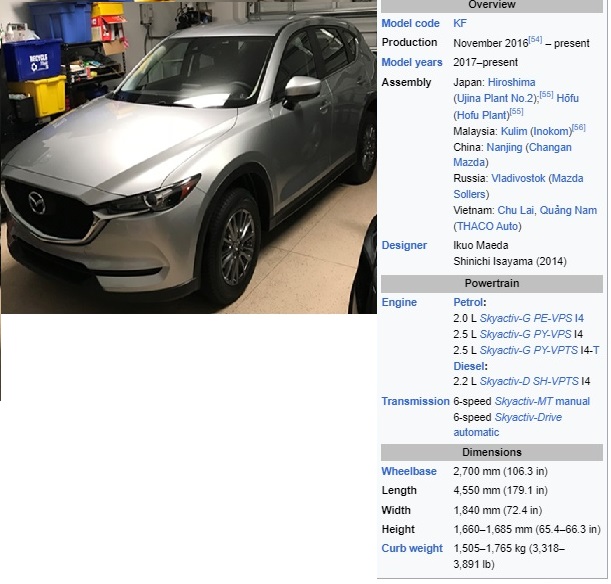 |
2018 Mazda CX5 | After saying goodbye to Betsy, our beloved Honda Odyssey, we needed a practical and affordable option to replace her. With three cars in the family and student loans to pay off for the kids, we decided leasing was the best choice to keep payments manageable. That’s how we ended up with the Mazda CX-5—a compact SUV that struck a great balance between size, price, and performance. The CX-5 turned out to be a solid daily driver. Its 2.5L four-cylinder engine was surprisingly peppy and made it fun to drive, especially for a car in its class. It handled our needs well, shuttling us back and forth to work reliably, though it wasn’t a car that sparked much excitement or made headlines in our lives. Before we knew it, the three-year lease was up, and it was time to return it. Mazda got back a low-mileage, garage-kept car that I’m sure they were happy to receive. For us, it was just a practical chapter—a dependable workhorse during a busy time in our lives. No big adventures or stories to tell, but it did exactly what we needed it to do. |
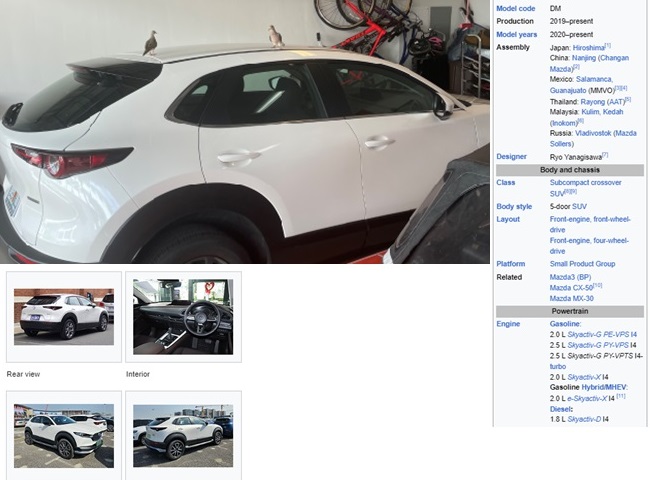 |
2021 Mazda CX30 | When the lease was up on the Mazda CX-5, Ed was sent solo to the Mazda dealership to pick out a replacement. After chatting with the trusted Mazda salesperson, Ed came home with something a little different: a CX-30. It was a newer type of vehicle—a crossover that looked very similar to the CX-5 but was slightly smaller. At first glance, it seemed like a logical choice. Surprisingly, the CX-30 had the same 2.5L engine as the CX-5, so it didn’t offer any improvement in gas mileage despite its smaller size. While it was fine as a daily driver, it wasn’t particularly exciting or memorable. It quickly became clear that the CX-30 was just too small for our needs. Everywhere we went, it felt like people thought we were part of the help—not exactly the impression we were looking for. The CX-30 didn’t stick around for long, but it served its purpose during its brief time with us. It was a practical choice for getting from point A to point B, but ultimately, it wasn’t a car that fit us or our lifestyle. |
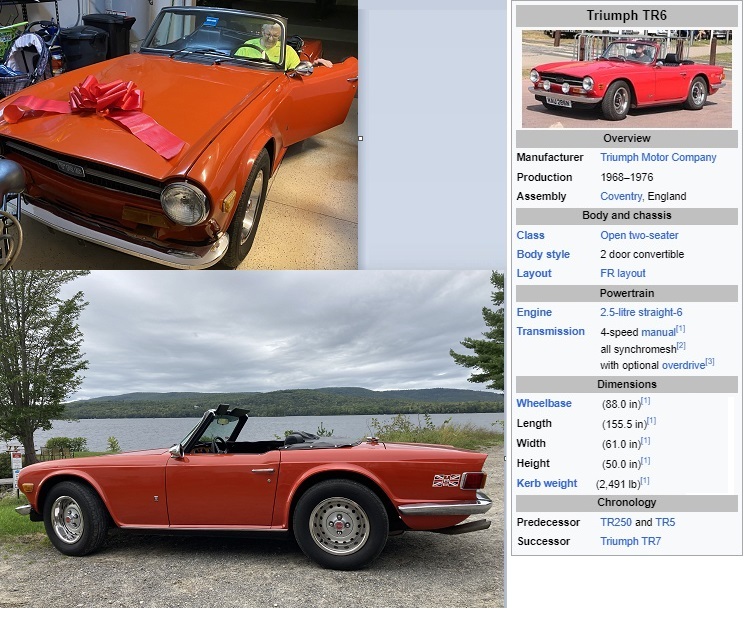 |
1973 Triumph TR6 | The first time Ed saw a red Triumph TR6 in the early 1970s, he was mesmerized. There was something about its classic design, low-slung stance, and sporty charm that captured my imagination. Ed knew, even as a kid, that one day I’d have one of my own. It was the car Ed dreamed about for years, my ultimate favorite. And now, Ed can proudly say he owned one. Driving the TR6 has been nothing short of amazing. The straight-six engine pulls with surprising power for a car from the early ’70s—far more robust than your typical English sports car of that era. Every time Ed got behind the wheel, I’m reminded of why it stood out to me all those years ago. It’s not just the performance, though; the TR6 has a way of drawing people in. Ed received more waves, honks, and appreciation from strangers in this car than with any other he owned. There’s something about it that sparks nostalgia and admiration wherever it goes. That said, owning a TR6 hasn’t been without its challenges—especially as a daily driver. Overheating while waiting for the drawbridge to open, coaxing the battery to cooperate and start the car, and dealing with its quirks has made every day an adventure. But despite the frustrations, Ed never regretted it. Owning a TR6 wasn’t just about having a car—it was about fulfilling a lifelong dream, checking off a punch list item I’d carried with me for decades. It hasn’t been perfect, but that’s what makes it special. The TR6 isn’t just a car; it’s a connection to the past, a reminder of the dreams Ed held onto, and proof that sometimes, the things we wait for really are worth it. |
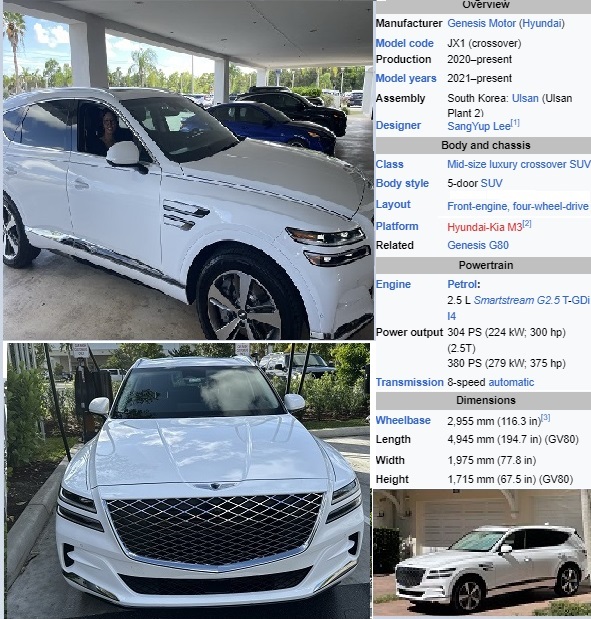 |
2023 Genesis GV80 | During the end of Covid, we started looking for a car to replace our Mazda CX-30. While the Mazda was a great little crossover, it was just a bit too small and didn’t quite have the prestige we were looking for. Initially, we set our sights on a Toyota Sienna minivan, but with two-year waiting lists or older models as the only options, we had to rethink our plans. By chance, we stopped at a Genesis dealership to check out the GV80, a model we’d read glowing reviews about. The moment we saw the white GV80 on the showroom floor, we were smitten. We decided to throw out a ridiculously low offer—$10,000 under MSRP—and told them we’d buy it if they could meet that price. Honestly, Ed didn’t think they’d go for it, especially during Covid and with it being a 2023 model in the summer of 2022. But to my surprise, they accepted! In one day, we traded in the Mazda and drove home in our new Genesis GV80. The car was stunning, and several people even remarked that it looked like a Bentley—which, to be fair, it kind of does. We took it on one incredible road trip to Dallas, and the experience was everything we could’ve hoped for: smooth, luxurious, and comfortable. It was the perfect car in so many ways. However, as much as we loved the GV80, it didn’t quite fit our long-term needs. Doreen and Ed wanted to take a lot of road trips, but Ed realized I’m not able to handle long-distance driving anymore without help. My attention span for driving fades after 15 minutes, and at my age, it’s just easier to have a little assistance. That’s why we ultimately traded it in for a Tesla Model X with Full Self-Driving (FSD). The Genesis was amazing, but the Tesla’s self-driving capabilities are a must for me now. Still, the GV80 holds a special place in our memories—it was an incredible car, even if its time with us was brief. |
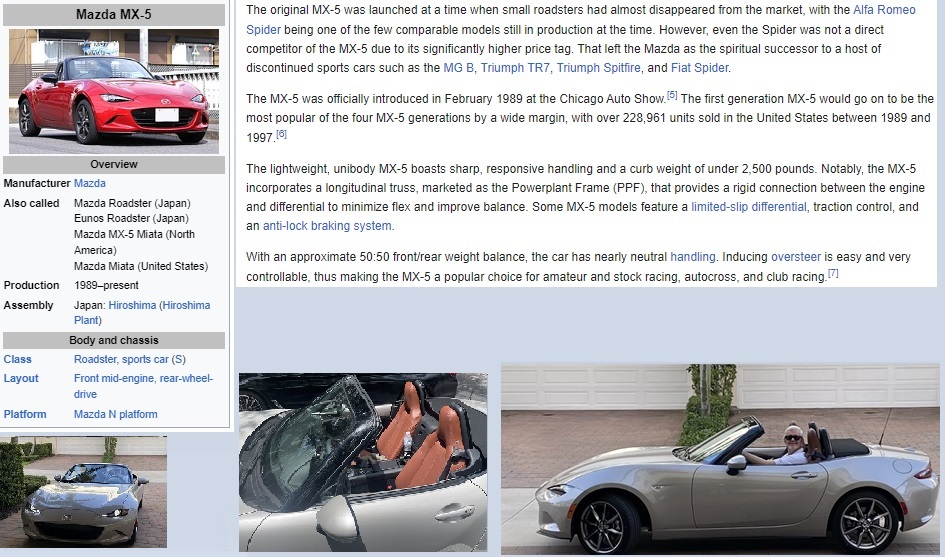 |
2023 Mazda Miata MX5 | When Doreen decided to return to work after finding retirement a little too boring, we realized we needed a second car again. We wanted something reliable but also fun to drive. After experiencing the thrill of the TR6—but not its reliability—it was clear we needed something that wouldn’t leave us stranded. The Mazda Miata MX-5 fit the bill perfectly. Even though the price was higher than Ed initially expected, the Miata has proven to be a great choice. It’s lightweight, zippy, and endlessly fun to drive. Most of the time, the top is down—especially now that I’m retired. Back when Ed was working, the top would go down occasionally, but these days it stays down almost all the time, even in a light drizzle. There’s just something about the feeling of the open air that makes every drive a little better. That said, Ed know the Miata isn’t a keeper for me. While it’s been great for this chapter of my life, I’m already thinking about what’s next—something a bit more masculine, like a replica AC Cobra. Let’s see if Ed can find one at a reasonable price. For now, though, the Miata has been exactly what Ed needed: reliable, fun, and the perfect companion for this season of life. |
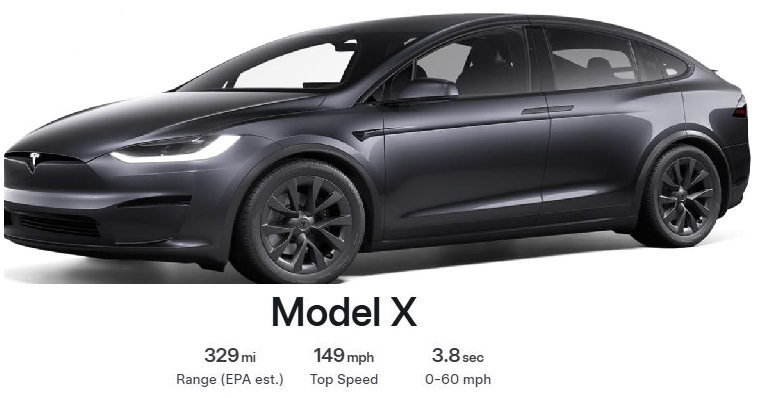 |
2024 Tesla Model X Long Range | The Tesla Model X had been on my radar for years, but the price always felt out of reach. That changed recently, thanks to a significant price reduction, a $7,000 discount on Full Self-Driving, and the $7,500 tax credit. With those incentives, we decided it was finally time to take the plunge—or rather, push the button—and purchase the 2024 Model X. So far, it’s been nothing short of amazing. The Model X is incredibly quiet and smooth, and it’s shockingly fast. At 0-60 mph in just 3.8 seconds, it’s the second fastest vehicle Ed ever owned—barely edged out by my 2016 Corvette by just 0.1 seconds. Driving it feels futuristic, though there are some things we’ve had to adjust to. The small sun visors are less than ideal, and the one-pedal driving system took some getting used to. That said, once we adapted, we really came to appreciate the one-pedal functionality. The button-based signaling, however, remains a bit tough to get used to. The Full Self-Driving (FSD) has been a real game-changer. When we first started using it, it felt clunky, but it has steadily improved and is now nearly flawless. It has truly been a lifesaver for my aging eyes and reflexes. We’ve used FSD for long road trips, from Nashville to the Florida Keys and even up to New York. It handles the miles with ease, and we’ve never had a single issue finding a charging station along the way. The car comfortably drives 2.5 to 3.5 hours before needing a charge, which has fit seamlessly into our travel routine. The Model X is everything we hoped it would be—a revolutionary vehicle that’s both practical and thrilling. |
Steve's Vehicles
| Make & Model | Story | |
|---|---|---|
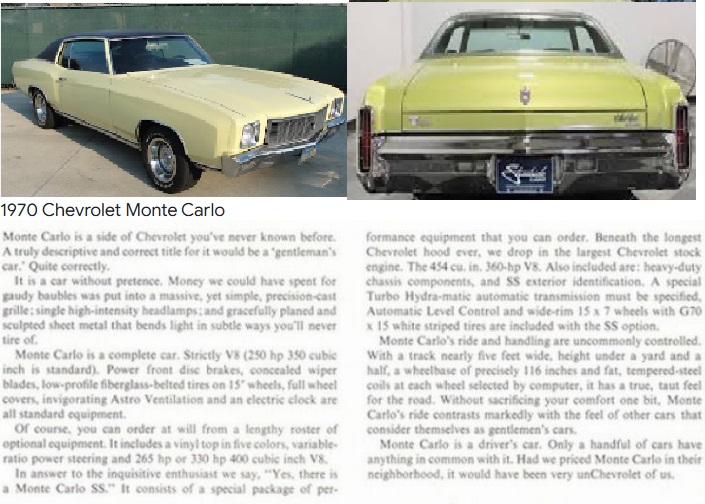 |
1970 Chevrolet Monte Carlo | Steve’s first car was a 1970 Chevrolet Monte Carlo, which he purchased near the Elms off Crisfield street. At one time, this car must have been stunning—a true classic with its long hood, sleek lines, and timeless design. It was equipped with a big V8 engine that delivered plenty of power, but it came with a mechanical carburetor that made it tricky to keep running or even get started on a normal basis. It required just the right touch, adding a layer of challenge to an already temperamental first car. Even though it wasn’t brand new when Steve got it, the car’s beauty still shone through, making it a memorable first ride. While it’s unclear if the brakes would always work, its quirks and classic charm left a lasting impression on Steve. As a first car, it represented freedom, independence, and the start of countless adventures. The Monte Carlo wasn’t just a car—it was a milestone, a piece of automotive history that Steve always remembered fondly. |
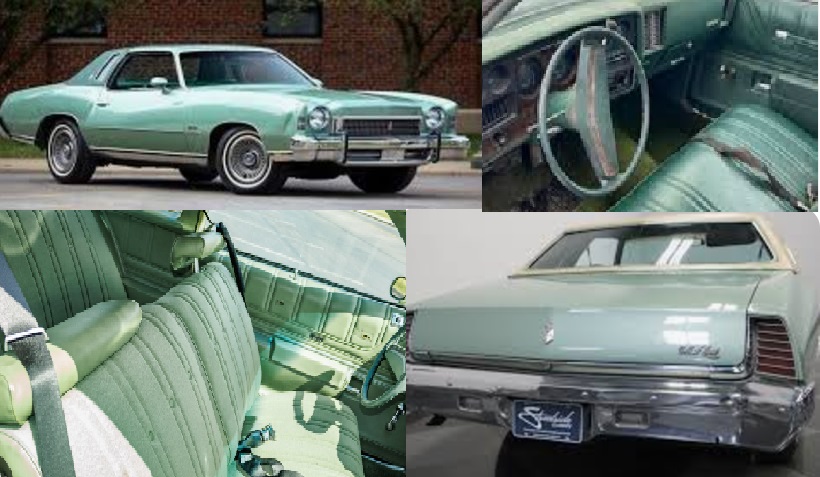 |
1973 Chevrolet Monte Carlo | Steve loved his 1970 Monte Carlo so much that he decided to buy another one—a newer model that was not only beautiful but ran far better than his first. The 1973 Monte Carlo exemplified everything a personal 2 door luxuary car was known for at the time. Its ride quality was almost unmatched, offering an unbelievably quiet and comfortable experience on the road. The steering on these classic “land yachts,” however, was a different story. While incredibly smooth, it lacked precision. You could sway the steering wheel side to side, and the car would often keep going straight—a quirk that was both amusing and a little unnerving. One memorable drive sticks out in particular. Steve was driving with Ed down the Bronx River Parkway, passing Lawrence Hospital, just before the road merged with the Sprain Brook Parkway. The ride was so smooth and quiet that it felt like gliding. That moment captured the essence of the Monte Carlo: it wasn’t about speed or sharp handling, but comfort and elegance, offering a relaxing ride that could make any journey feel special. The 1973 Monte Carlo was more than just a car—it was a symbol of a luxurious automobile yet accessible. Steve always remembered how much he enjoyed driving it, a car that delivered both style and comfort in spades. |
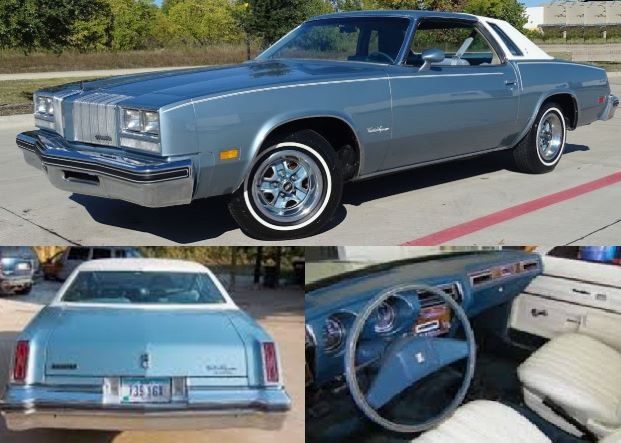 |
1977 Oldsmobile Cutlass Supreme | Steve loved his 1970 Monte Carlo so much that he decided to buy another one—a newer model that was not only beautiful but ran far better than his first. The 1973 Monte Carlo exemplified everything a personal 2 door luxuary car was known for at the time. Its ride quality was almost unmatched, offering an unbelievably quiet and comfortable experience on the road. The steering on these classic “land yachts,” however, was a different story. While incredibly smooth, it lacked precision. You could sway the steering wheel side to side, and the car would often keep going straight—a quirk that was both amusing and a little unnerving. One memorable drive sticks out in particular. Steve was driving with Ed down the Bronx River Parkway, passing Lawrence Hospital, just before the road merged with the Sprain Brook Parkway. The ride was so smooth and quiet that it felt like gliding. That moment captured the essence of the Monte Carlo: it wasn’t about speed or sharp handling, but comfort and elegance, offering a relaxing ride that could make any journey feel special. The 1973 Monte Carlo was more than just a car—it was a symbol of a luxurious automobile yet accessible. Steve always remembered how much he enjoyed driving it, a car that delivered both style and comfort in spades. |
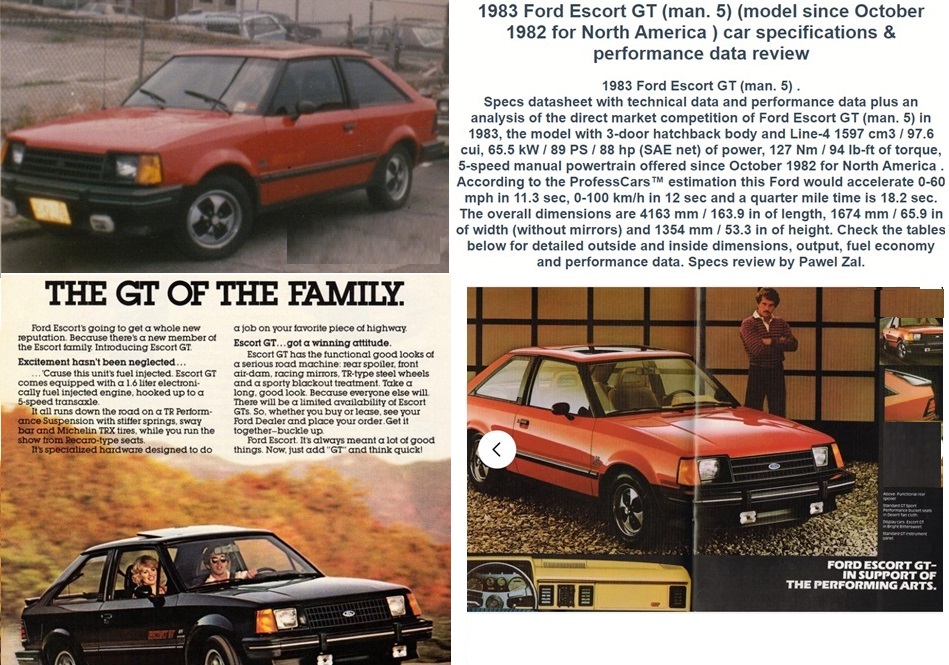 |
1983 Ford Escort GT | Steve’s first car purchase from a dealership was a significant milestone. He bought a 1983 Ford Escort GT from Curry Chevrolet on Central Avenue in Scarsdale, marking his first foray into both a manual transmission and car financing. The Escort GT came equipped with a five-speed manual, offering a different kind of driving experience compared to the luxury two-door sedans Steve had owned before. This car was much more practical than his previous rides. It offered better gas mileage, which was increasingly important given rising fuel prices at the time, and it was better suited for everyday driving. The Escort GT may not have had the elegance of a Monte Carlo, but it was sporty, economical, and reliable—a car that fit Steve’s needs during this chapter of his life. Steve drove the Escort GT for many years, using it for his daily commutes, trips to events, and everything in between. It was a practical yet meaningful step forward, representing Steve’s transition into a more economical and responsible approach to car ownership. Years later, however, the story of the Escort GT took an unexpected turn. Curry Chevrolet lost a court settlement over unfair interest rates on financing, and Steve ended up getting back thousands of dollars from the settlement. It was a surprising but welcome outcome, adding an interesting twist to the history of his first dealership purchase. While the Escort GT wasn’t the flashiest vehicle, it served its purpose well and marked an important phase in Steve’s driving journey—one that even came with an unexpected financial bonus years down the road. |
 |
1977 Datsun SX200 | While Steve’s 1983 Ford Escort GT was getting its engine rebuilt, he picked up an old 1978 Datsun (now known as Nissan) to hold him over until the Escort was back on the road. The engine rebuild was handled by Paul Votanno, a local mechanic who lived on Pennsylvania Avenue in Crestwood. The Datsun was far from perfect, but it served its purpose—for a while, at least. One particularly memorable story from Steve’s time with the Datsun happened near his apartment in Fairview Street in Yonkers. While driving down Ridge Avenye a steep hill, the car’s front tire suddenly fell off with incredible force. The combination of the hill’s steepness and the speed of the spinning wheel created a dangerous—and almost comical—situation. By what could only be described as God’s luck, the tire narrowly missed an elderly man gardening in front of his house. The man, understandably startled, muttered under his breath, “Kids these days…” as the rogue tire bounced past him. The Datsun didn’t last much longer after that incident. Between its questionable reliability and the scare with the tire, it quickly became clear that the car’s days were numbered. Still, it added an unforgettable chapter to Steve’s automotive adventures, serving as a reminder that sometimes, the cars we need in a pinch can bring the wildest stories. |
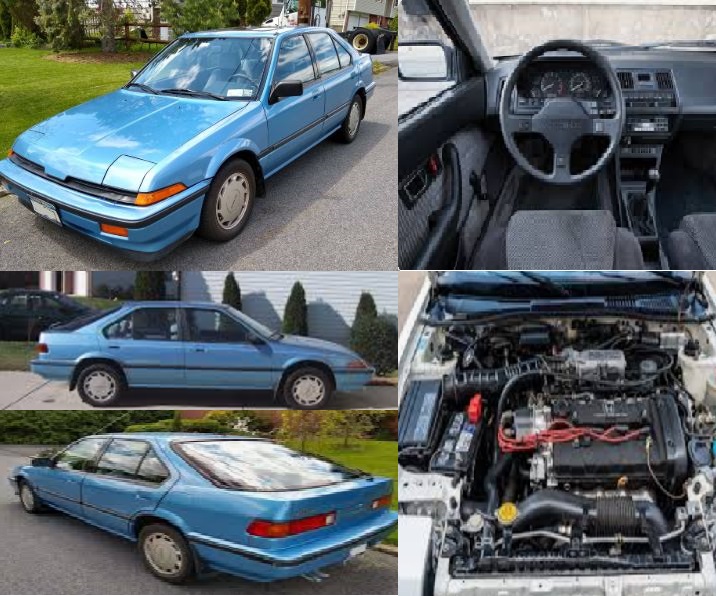 |
1987 Acura Integra LX | After years of struggling with unreliable cars, Steve found an amazing and upscale vehicle—the 1987 Acura Integra LX. He purchased the car from Larchmont Acura, marking the beginning of a long and valued relationship with the dealership. With its exceptional service and quality vehicles, Larchmont Acura became a trusted source for Steve’s automotive needs for years to come. The Integra itself was a game-changer. With its 1.6L dual overhead cam 16-valve four-cylinder engine, the car delivered an impressive combination of performance and fuel efficiency. It was part of Acura’s surge in the U.S. market, proving that compact cars could be both refined and powerful. The Integra offered excellent gas mileage while still packing a punch, and it became one of Steve’s most reliable and enjoyable cars, staying with him for over a decade. One particularly memorable story from Steve’s time with the Integra involved helping Ed with some serious yard work at his house in Abbeville. Ed needed to move rocks—actually boulders—across his backyard, and the Integra was drafted into service. With a little ingenuity (and probably a lot of strain on the clutch), the Integra managed to drag those massive rocks across the yard. While it got the job done, it’s safe to say the car’s transmission probably didn’t appreciate the heavy lifting. Despite that unconventional task, the Integra held up remarkably well and became a trusted companion for Steve over the years. It wasn’t just a car—it was a symbol of reliability, performance, and the kind of practicality that made it perfect for both daily commutes and the occasional backyard boulder-moving adventure. |
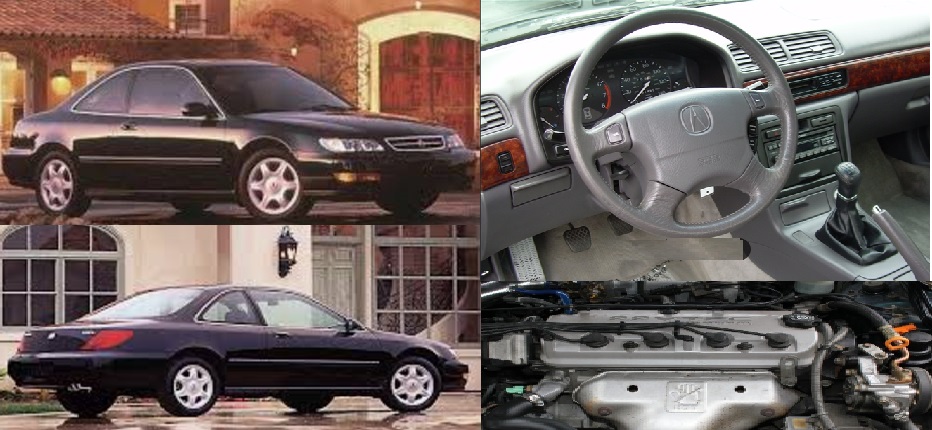 |
1997 Acura CL Coupe | As Steve’s advertising specialty business grew more successful, he decided it was time to reward himself with something special. In 1997, he splurged on a sleek and sporty Acura CL coupe, once again purchasing it from his trusted dealership, Larchmont Acura. This marked another chapter in his long-standing relationship with the dealership, which had consistently provided excellent service and quality cars. The CL coupe was a perfect choice for Steve at the time. Equipped with a five-speed manual transmission and a 2.2L VTEC engine, it offered a silky-smooth driving experience, blending sporty performance with Acura’s signature refinement. The coupe’s classy design and responsive handling made it a joy to drive and a step up in style from his previous cars. Steve kept the Acura CL for several years, enjoying it to the fullest. However, as his family grew—with a daughter and a son—so did the need for more space. The coupe’s two-door design and limited interior room weren’t ideal for a growing family, so the time eventually came to trade it in for something more practical. Even though the CL didn’t stay with him forever, it represented a moment of personal achievement, a time when Steve could enjoy the fruits of his hard work while still driving a car that reflected his love for performance, style, and quality. |
 |
2001 Odyssey EX | Steve and Lori got married in 2000, and with the arrival of their daughter, Lea, in 2001, their growing family needed a bigger car to accommodate their new lifestyle. They decided to go for the best minivan on the market at the time—the 2001 Honda Odyssey EX. It turned out to be an excellent choice. The Odyssey EX was everything they needed: spacious, reliable, and versatile. With seating for the whole family and plenty of room for strollers, groceries, and everything else life threw their way, it quickly became a mainstay in their daily lives. The Odyssey was also built to last, clocking in close to 200,000 miles over its lifetime, a testament to Honda’s legendary reliability. This minivan wasn’t just a family hauler—it was the centerpiece of many memorable moments. It became the go-to vehicle for tailgate parties at Giants football games, loaded up with food, drinks, and everything needed for a great day at the stadium. Whether it was a road trip, a grocery run, or a celebration in the parking lot before kickoff, the Odyssey was always up to the task. While it was eventually retired after many years of loyal service, the 2001 Honda Odyssey EX remained a symbol of a pivotal time in Steve and Lori’s lives—a car that grew with their family and carried them through countless adventures and milestones. |
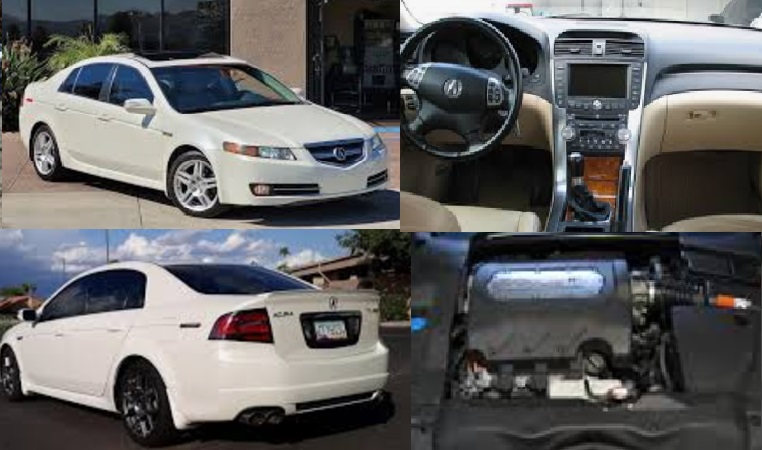 |
2005 Acura TL | As Steve’s family continued to grow, he needed a car that offered more space and comfort without sacrificing sportiness or modern features. Enter the 2005 Acura TL, a luxury sedan that checked all the boxes for performance, technology, and style. It was the perfect choice for a family man who still wanted to enjoy the thrill of driving. Powered by a 3.2-liter V6 engine producing an impressive 270 horsepower, the TL delivered spirited performance and smooth acceleration, thanks to its refined five-speed automatic transmission. Its sleek, aerodynamic design made it stand out on the road, while the well-appointed interior offered high-quality materials and cutting-edge technology for its time. Features like a premium audio system and optional navigation made every drive enjoyable, whether it was a quick commute or a weekend outing with the family. The TL was also known for its reliability and sporty handling, providing a balanced driving experience that appealed to both enthusiasts and everyday drivers. For Steve, it struck the perfect balance between practicality and performance, allowing him to enjoy the car’s luxury and power while meeting the needs of his growing family. Although Steve owned the Acura TL for many years, the mileage stayed relatively low, as he worked from home and had a short commute. This kept the car in excellent condition, ensuring it remained a comfortable and reliable companion for the years it was part of his life. The 2005 Acura TL wasn’t just a car—it was a reflection of Steve’s desire for a vehicle that combined family-friendly practicality with the sportiness and advanced features he valued. It served him well, providing comfort, technology, and a touch of excitement in his day-to-day life. |
 |
2014 Fort Shelby GT500 | After years of hard work, dedication, and grit—delivering incredible value to both his customers and his family—Steve decided it was time to reward himself with something truly extraordinary. He went out and bought a 2014 Ford Shelby GT500, a car that perfectly encapsulated his determination and success. The 2014 Shelby GT500 is no ordinary car; it’s a high-performance masterpiece. Under the hood lies a supercharged 5.8-liter V8 engine that produces an astonishing 662 horsepower and 631 lb-ft of torque, making it one of the most powerful production cars of its time. Paired with a six-speed manual transmission and rear-wheel drive, the GT500 delivers an exhilarating driving experience, capable of going from 0 to 60 mph in just over 3.5 seconds. It’s the kind of car that turns heads and delivers thrills every time you get behind the wheel. The exterior design is as bold as the performance, with an aggressive front fascia, a functional hood vent, a rear spoiler, and other aerodynamic touches that give it a distinctive presence on the road. Inside, the car blends sporty aesthetics with modern technology, featuring Recaro racing seats, premium materials, and an advanced audio system—making every drive both exciting and comfortable. For Steve, the Shelby GT500 wasn’t just a car; it was a symbol of how far he had come. It reflected his passion for performance, his appreciation for iconic American muscle, and his drive to achieve greatness in every area of his life. The GT500 wasn’t just about speed or power; it was about celebrating the journey that led to owning such a legendary vehicle. Even now, the 2014 Shelby GT500 stands as a testament to Steve’s hard work and perseverance—a car that embodies both raw power and refined engineering, just like the man who drives it. |
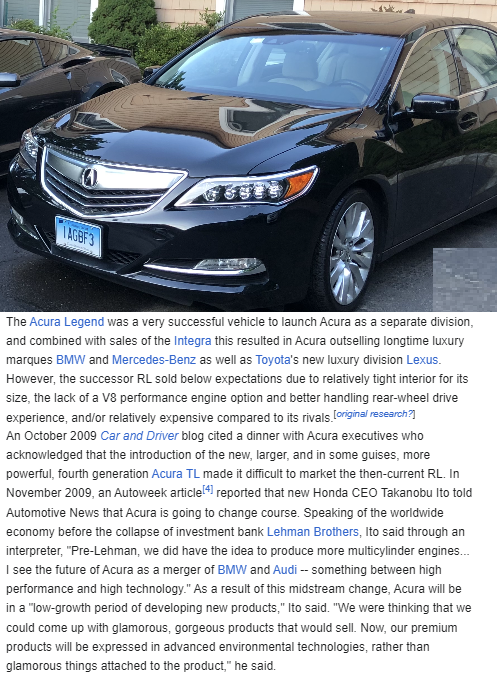 |
2015 Acura RLX | After years of enjoying his Acura TL, Steve decided to upgrade to something even more luxurious and spacious. In 2015, he purchased an Acura RLX, a flagship sedan that perfectly balanced performance, comfort, and cutting-edge technology. The RLX offered a smooth ride, a powerful yet refined V6 engine, and a host of advanced features that made every drive a pleasure. The RLX quickly became Steve’s go-to car for nearly a decade. Its roomy interior and premium materials provided exceptional comfort, while its advanced tech—including an impressive audio system and safety features—made it a standout vehicle. Whether he was commuting or taking a longer trip, the RLX delivered a quiet, luxurious ride that exceeded expectations. By 2024, the RLX had become a cherished member of the family. When Steve’s daughter, Lea, needed a reliable and stylish car, the RLX was the perfect fit. Passing the RLX to Lea marked the end of Steve’s time with the car, but it also ensured that it stayed within the family, continuing its legacy of dependability and comfort. The Acura RLX wasn’t just a car—it was a long-term companion that reflected Steve’s appreciation for quality and sophistication. From 2015 to 2024, it served him well, and now it’s ready for the next chapter with Lea behind the wheel. |  |
Couchmen Pursuit | The 2022 Coachmen Pursuit is a reliable and comfortable Class A motorhome built on a Ford F53 chassis with a 7.3L V8 engine delivering 350 horsepower. Available in multiple floorplans from 29 to 35 feet, it offers smooth handling and plenty of space for families or couples on road trips or weekend adventures. Inside, the Pursuit accommodates 6-8 people with a queen-size bed, convertible dinette, sofa sleeper, and optional drop-down bunk. The fully-equipped kitchen, full bathroom, and entertainment features like a 40” LED TV provide all the comforts of home, while ducted air conditioning and heating ensure year-round comfort. Its durable fiberglass exterior includes a power awning, backup cameras, and ample storage. While its fuel efficiency is typical for Class A motorhomes, the Pursuit’s thoughtful design, modern amenities, and competitive pricing make it an excellent choice for road travelers seeking convenience and value. |
 |
2017 Chevrolet Corvette Grand Sport | Steve, always a Chevrolet enthusiast, made the transition from his powerful Shelby GT500 to something equally thrilling: a 2017 Corvette Grand Sport. Finished in a stunning dark gray, the Grand Sport combined the iconic design of the Corvette with the high-performance features of the Z06, creating a car that perfectly matched Steve’s passion for speed, style, and American engineering. Under the hood, the Grand Sport packed a 6.2-liter V8 engine, delivering an impressive 460 horsepower. Paired with a lightweight chassis, advanced aerodynamics, and a track-ready suspension, the car offered an exhilarating driving experience, whether on the open road or pushing its limits on the racetrack. It struck the ideal balance between raw power and precision handling, making every drive unforgettable. For Steve, the C7 Grand Sport wasn’t just a car—it was the embodiment of Chevrolet’s legacy in performance and innovation. It honored his loyalty to the brand while giving him a modern, refined driving experience that matched his love for high-performance vehicles. Whether cruising on the highway or carving through corners, the Grand Sport delivered in every way, cementing its place as one of Steve’s all-time favorite rides. | 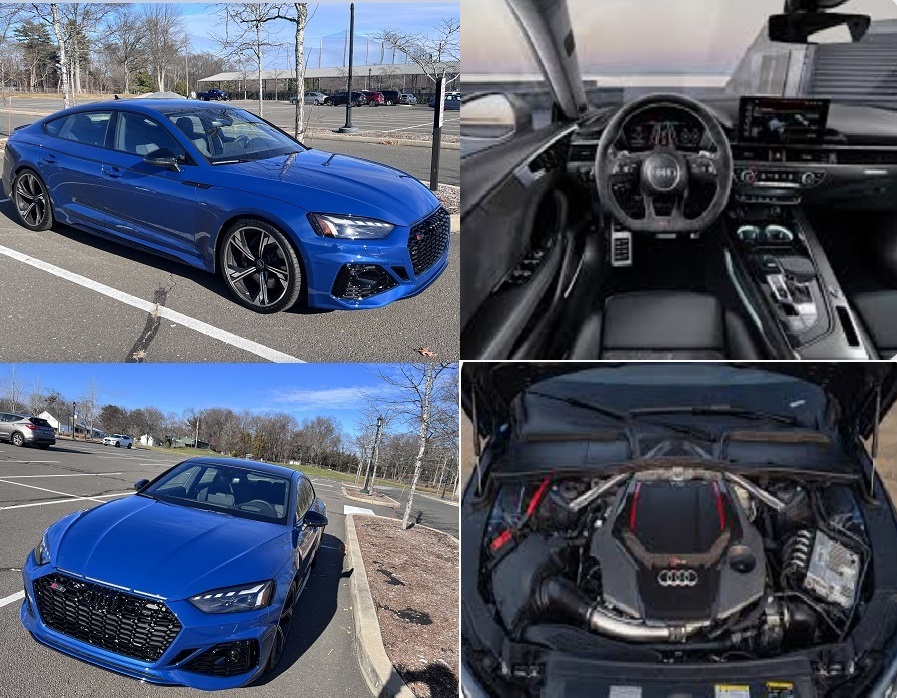 |
2023 Audi RS5 Sportback | With a growing number of vehicles in the driveway—including an RV—it was time for Steve to simplify and consolidate his fleet. The solution? Combine the performance and thrill of his two-door C7 Corvette, and the luxury and practicality of his Acura RLX into one vehicle that could do it all. The Audi RS5 Sportback was the perfect choice. The Audi RS5 Sportback masterfully blends high-performance engineering with everyday practicality. Powered by a twin-turbocharged V6 engine, it delivers exhilarating acceleration and dynamic handling that rivals pure sports cars. At the same time, its sleek four-door design and spacious interior make it ideal for daily use, long trips, and even family outings. Inside, the RS5 Sportback doesn’t skimp on luxury. The cabin is crafted with premium materials and cutting-edge technology, providing both comfort and sophistication. From its advanced infotainment system to the supportive sport seats, every detail is designed to enhance the driving experience. For Steve, the RS5 Sportback represented the best of both worlds. It offered the heart-pounding excitement of a sports car with the practicality and refinement of a luxury sedan. Whether carving through twisty roads or cruising in style, the RS5 Sportback delivered on every front, making it the perfect choice for this new chapter in his automotive journey. | 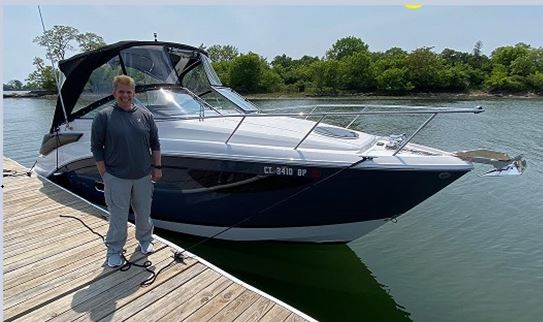 |
2023 Regal 26 XO | The Regal 26 XO is engineered for ultimate versatility. Handcrafted with attention to every experience-enhancing detail. The Regal 26 XO is a refined cruiser that meets an elevated standard of excellence. With a wide variety of amenities available both above deck and below, this boat is designed to keep you—and your guests—feeling comfortable, relaxed and refreshed all day long. | 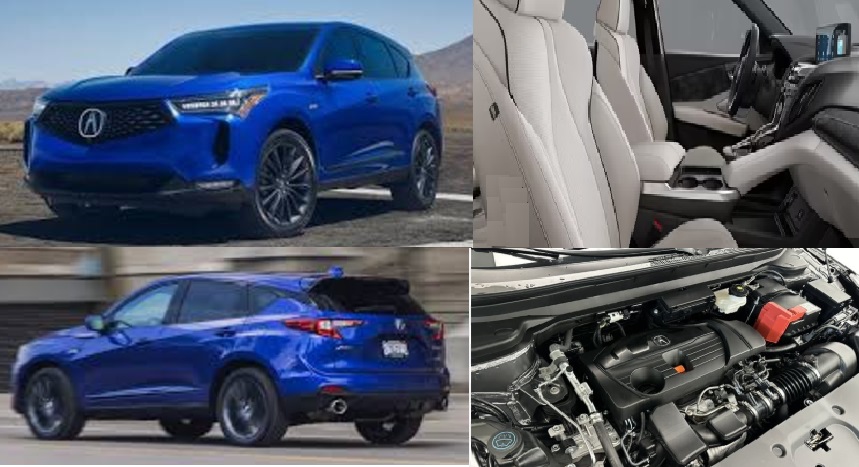 |
2024 Acura RDX A Spec | When Lori decided it was time to move on from years of driving a minivan—now that the kids had grown up—she made the switch to an Acura RDX. Lori has enjoyed the RDX so much this is now her third one in a row, a testament to how much she loved the compact luxury SUV. For this latest iteration, Lori chose the sporty A-Spec trim, which added an extra dose of style and excitement to her daily drives. The sharp design, upgraded interior, and performance-oriented features made every commute or errand enjoyable. It was the perfect blend of practicality and sportiness, allowing Lori to enjoy a luxurious yet dynamic driving experience. The RDX A-Spec wasn’t just a car; it was a reflection of a new chapter in Lori’s life, where she could prioritize a vehicle that was both stylish and fun to drive, all while retaining the reliability and comfort Acura is known for. |
Mom and Dad's cars
| Make & Model | Story | |
|---|---|---|
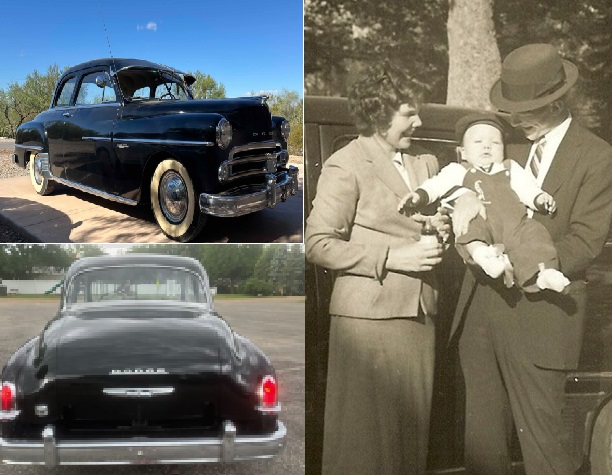 |
1950 Dodge | Peter and Nancy’s first car, a 1950 Dodge, though not new and finished in the standard black paint of the time, was well-suited for their needs. It would have been a durable and reliable vehicle, typical of Dodge’s reputation during the post-war era. The car’s straightforward design and sturdy six-cylinder engine would have been adequate for regular trips between the Bronx and Crestwood, a distance of about 15-20 miles depending on the route. While it may not have been flashy or modern, the 1950 Dodge’s rugged construction and no-nonsense engineering made it a dependable mode of transportation for city and suburban travel. For Peter and Nancy, it was likely an affordable and practical choice, embodying the spirit of getting where they needed to go without unnecessary frills—a perfect fit for the demands of the time. |
 |
1956 Dodge Custom Royal | The first family car owned by Peter and Nancy was a 1956 Dodge Custom Royal, a stylish and innovative vehicle for its time, featuring the futuristic Torqueflite push-button transmission. This car marked the beginning of their driving adventures and played a key role in Nancy’s journey to becoming an exceptional driver. Nancy’s early driving days were not without a few hiccups. She earned the nickname “The Canopy Kid” after a memorable learning experience in the Lord & Taylor parking lot. While practicing how to drive a manual transmission, she mixed up the gas and brake pedals, accidentally hitting the canopy in front of the store. Though it was an embarrassing moment at the time, it didn’t deter her—it only fueled her determination to improve. Over time, Nancy became an incredible driver, known for her mastery of shortcuts and her confidence behind the wheel. The 1956 Dodge Custom Royal was her stepping stone, helping her gain the skills and independence that defined her driving for decades. She continued driving well into her late 80s, a testament to her resilience and capability. The Dodge Custom Royal wasn’t just a car—it was a piece of family history and the vehicle that set Nancy on her path to becoming the amazing driver she was known as for so many years. |
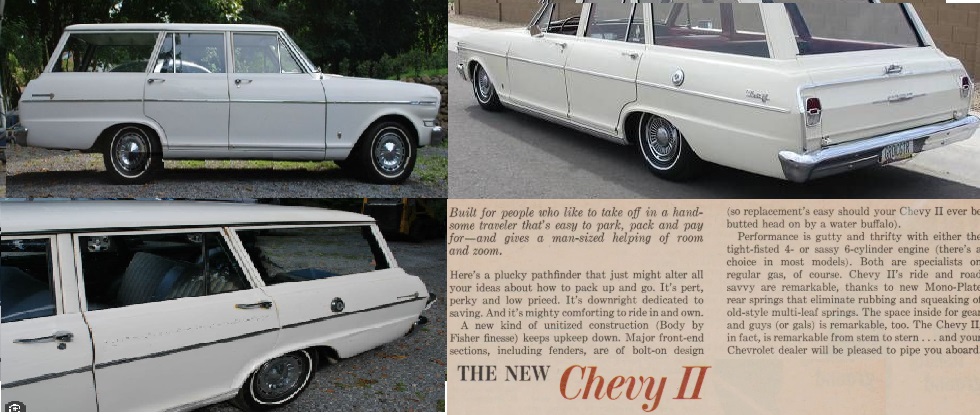 |
1962 Chevrolet Nova | Peter and Nancy had a 1960 Chevy Nova II station wagon, a true workhorse of its time, tasked with hauling their five kids to countless places. With its classic lines and utilitarian charm, the car fit the family’s needs, even if it wasn’t always the most dependable ride. The Nova II was somewhat reliable, but like many cars of its vintage, it had its fair share of breakdowns. The family can still recall a few of those moments when it left us stranded, a reminder of how far car technology has come. But for all its quirks, it served its purpose, shuttling the family through the chaos of life with five kids in tow. It may not have been perfect, but the Nova II was more than just a car—it was part of the fabric of family life, carrying us through memories, challenges, and everyday adventures. |
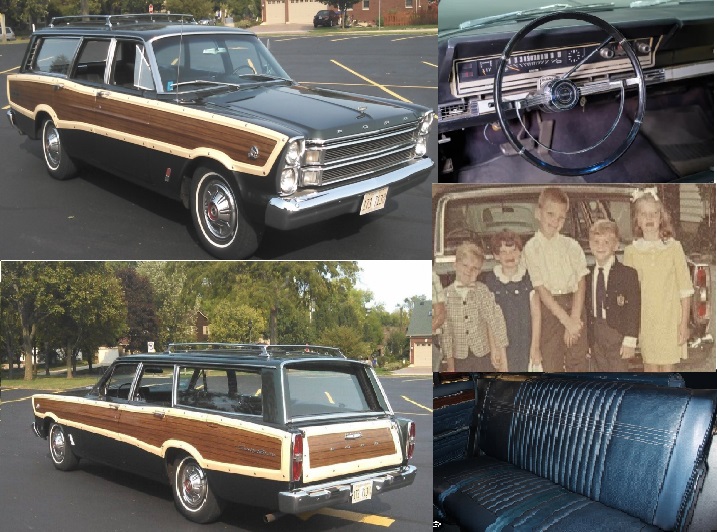 |
1966 Ford Fairlane 500 Squire | In the late 1960s, Peter and Nancy purchased a 1966 Ford Fairlane 500 Square Station Wagon from a dealership on North Avenue in New Rochelle. It was a striking car for its time, with dark green paint and wood paneling—a combination that my father absolutely loved. As far as station wagons go, this one stood out, both in looks and in its place in our family’s history. The Fairlane 500 was large enough to fit all seven of us: Mom, Dad, the five kids, and the twins, who had the special spot in the pop-up seats way in the back. Those seats were like a built-in adventure for us kids, facing backward and giving us a view of the road behind. For a car tasked with managing a big family, it did the job well, and it quickly became one of my father’s favorite vehicles. If ever there was such a thing as a “favorite station wagon,” this was it. One memorable story with the Fairlane happened during a trip to Winterclove in the early 1970s. My dad, always ready to help someone out, assisted a friend whose car battery had died. Unfortunately, when connecting the jumper cables, the positive and negative were accidentally reversed. The mistake ended up frying the Fairlane’s electrical system, and it was never quite the same after that. Despite repairs, the car’s reliability was affected, and it eventually had to be retired. |
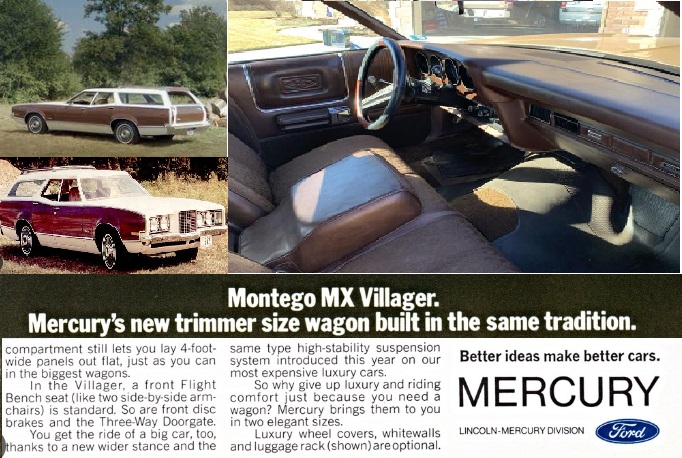 |
1972 Mercury Montego MX Villager | The next car Peter and Nancy purchased was a beautiful Mercury station wagon, a car they were truly proud of. It was bought during their peak earning years, just before the oil crisis hit, and it felt like a symbol of their hard work and success. The car featured a powerful V8 engine and came in Nancy’s favorite color—white—with classic faux wood trim along the sides. But what really set it apart were the bells and whistles. It was equipped with power windows and luxurious bucket seats—features that were rare for station wagons at the time and made the Mercury feel a cut above the rest. The Mercury quickly became a cornerstone of family life, taking the family on countless trips and handling a variety of tasks. It even hauled the family sailboat, the Red Baron, up to Connecticut and back. On another occasion, it was loaded up with yards of gravel to help landscape Grandpa’s backyard. The station wagon wasn’t just a car; it was a tool that made big family projects possible. Over the years, it also became a key part of the kids’ lives. Steve and Pete all learned to drive in the Mercury, with Steve eventually taking over the car to shuttle the twins to high school. However, the second oil crisis changed everything. As gas prices soared, the powerful V8 engine that once felt like a luxury became an unsustainable expense. As it started to show it is age, and as the older kids got their own cars Peter and Nancy reluctantly had to let the Mercury go. |
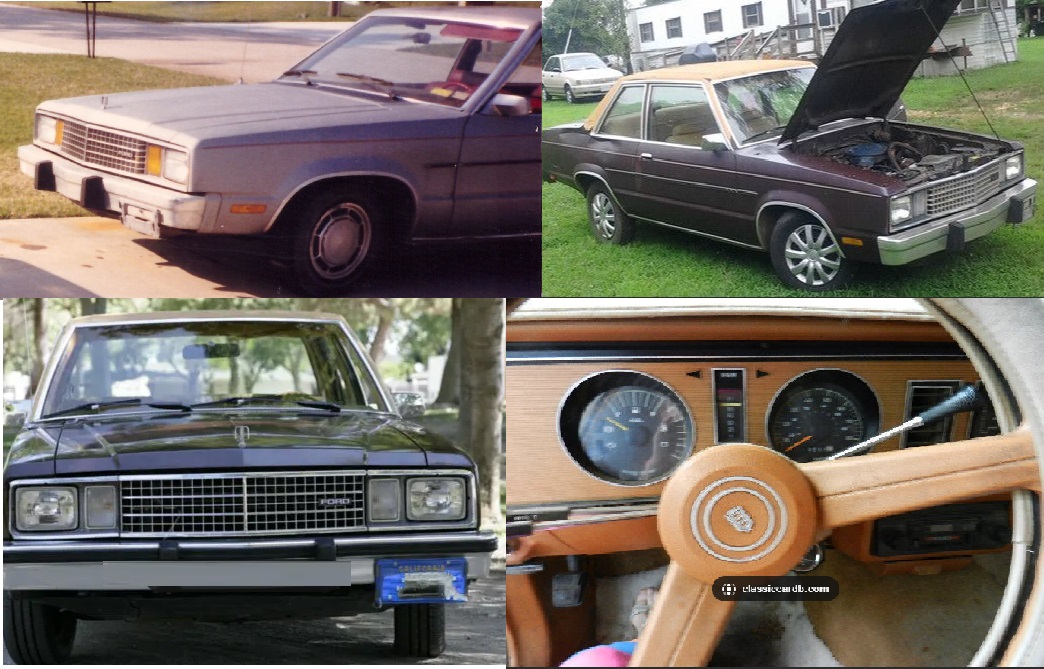 |
1978 and 1980 Ford Fairmount | During the challenging economic times of high inflation, high unemployment, the gas crisis, and soaring interest rates, Peter and Nancy transitioned to more economical cars to manage their budget. One of their key choices was the Ford Fairmont, a practical and reliable car that became a staple of the family. In 1978, Dad purchased the first Fairmont, a brown sedan with an orange vinyl roof and a wimpy four-cylinder engine. How wimpy? We found out firsthand during trips to drive Maryhelen to college—on steep hills, other cars would easily pass us. However, going downhill, it was our turn to overtake the pack! Despite its lack of power, the car proved to be incredibly reliable, so much so that Mom decided to get her own Fairmont two years later. Her 1980 model came with a straight-six engine, offering a noticeable improvement in performance. The 1978 Fairmont played a significant role in family life. It was in this car that Ed learned to drive, and I’ll never forget one unforgettable incident during his first week with a new license. He decided to take it for a joyride on the Bronx River Parkway. After exiting at McLean Avenue and pulling up to a stoplight, the car refused to move again—the transmission had completely failed. I’m sure Dad was thrilled to hear that news. As for the 1978 Fairmont, it met its end in a more dramatic way. After running for 60,000 miles without an oil change, the engine seized—unsurprisingly, the oil had turned to tar. Meanwhile, the 1980 Fairmont lived a long and useful life. Even after the mom and dad moved to Florida, Dad continued to drive it, despite its vinyl seats and lack of air conditioning in the sweltering Florida heat. |
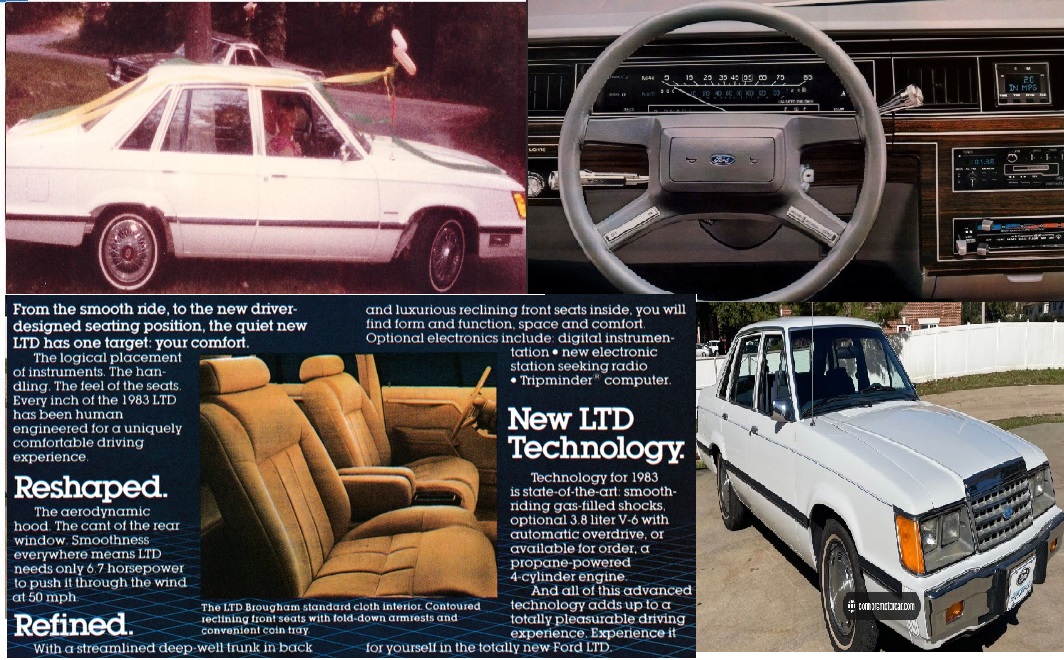 |
1983 Ford LTD Brougham | The 1983 Ford LTD Brougham was a significant upgrade from the utilitarian Fairmonts the family had driven previously. It felt luxurious by comparison, with its plush crushed velour seats and air conditioning—a stark contrast to the gray 1980 Fairmont, which had vinyl seats, an AM radio, and no AC. The LTD was a car built for comfort and a welcome change for everyone. One memorable trip in the LTD was the family’s drive to Florida. With Mom, Dad, and Ed rotating as drivers, the journey was long but made far more enjoyable by the LTD’s superior features. Everyone eagerly waited their turn to sit in the LTD, as the difference in comfort compared to the Fairmont was night and day. The cool air from the AC and the soft velour seats felt like a luxury, especially after enduring the hot and sticky vinyl seats of the Fairmont. The LTD Brougham wasn’t just a car; it was a symbol of progress for the family, bringing a touch of elegance to their travels. It turned long drives into more pleasant experiences and proved to be a reliable and comfortable companion during those years. Compared to the barebones practicality of the Fairmonts, the LTD was a much-appreciated step up in style and comfort. |
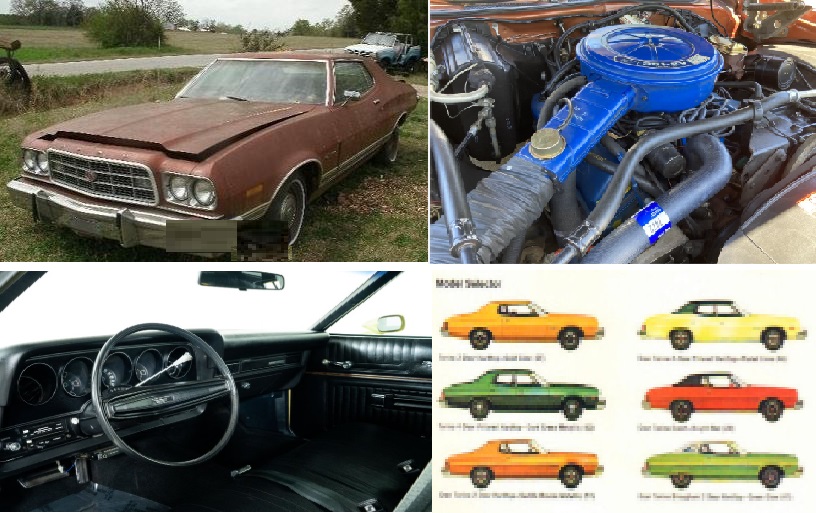 |
1973 Ford Torino | After the 1980 gray Fairmont literally faded away in the relentless Florida heat, Dad replaced it with a 1974 Ford Torino. This car was as bare-bones as it gets—AM radio, vinyl seats, roll-down windows—but it did have one luxury: air conditioning. Unfortunately, that AC had to work overtime to compensate for the black vinyl seats, which absorbed the Florida sun like a furnace. On the bright side, the Torino was equipped with a 302 cubic-inch V8 engine, providing a surprising amount of power for a car of its class. Ed has a particularly vivid memory of the Torino from 1985, when he drove it back to Tampa after starting his job selling cars. The trip took him across Route 60, a desolate stretch of road flanked by little more than cows and vultures. While the strong V8 made the drive exhilarating, Ed couldn’t help but worry whether the 11-year-old car would actually make the 160-mile journey. Thankfully, it did—proving the Torino’s reliability, at least for that day. Another memorable moment came during one of those brutally hot Florida summers. Ed had just finished a day of car sales training in August, only to discover the black steering wheel had absorbed so much heat that it was literally untouchable. Even after waiting 20 minutes with the AC blasting, the wheel was still scorching. In a stroke of ingenuity (and desperation), Ed wrapped his tie around his hands just to be able to grip the wheel and drive home. |
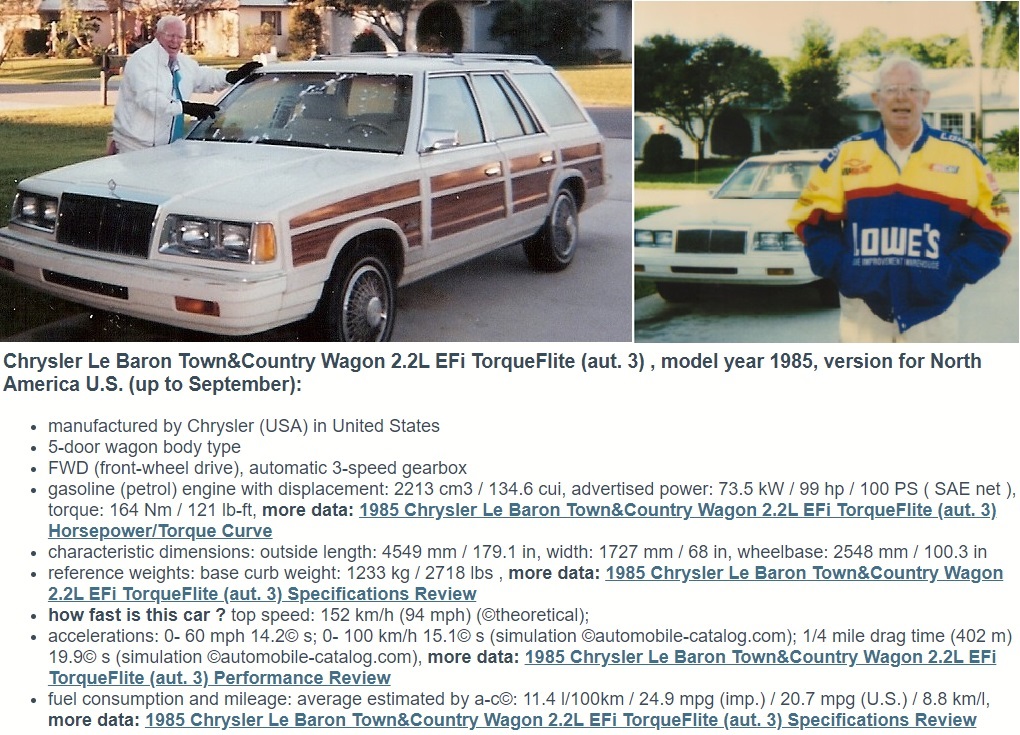 |
1985 Le Baron Town & Country | After the uncomfortable and somewhat unsuccessful experience with the 1974 Torino, Dad decided to go for something more his style—a 1986 Chrysler LeBaron station wagon with wood paneling. Dad had always loved the look of faux wood panels, and the LeBaron’s trim seemed more refined and upscale compared to the previous Mercuries, Montegos, and Ford Fairlanes he had owned. This car felt like a return to form for him, and he was incredibly proud of it. The LeBaron was not just a practical family wagon; it was a car Dad took great care of. Its classic design, combined with the wood-paneled exterior, gave it a touch of elegance that fit Dad’s taste perfectly. He made sure to keep it in excellent condition, and it served the family well for several years. Unfortunately, the LeBaron met a tragic end. During one of Florida’s infamous hurricanes, the car was badly damaged, rendering it unusable. It was a sad day for Dad, as the car wasn’t just a mode of transportation—it was something he truly loved and was proud to own. Saying goodbye to it felt like the end of an era. The 1986 LeBaron station wagon wasn’t just another car in Dad’s collection. It was a reflection of his style and pride, and it stood out as one of the vehicles he cherished most during his life. |
 |
1989 Ford Taurus | After the beautiful LTD, Mom and Dad upgraded to an even more impressive car—top-of-the-line, loaded with digital features, and equipped with all the options. The only potential downside was that Dad purchased it as a demo or manager’s car, which may have caused some long-term issues, but at the time, it was stunning. The car had a unique dark salmon exterior with a luxurious dark red velour interior, making it a standout in both style and comfort. The “Tour interior” likely referenced premium features, combining high-end materials with cutting-edge technology of the era, like digital displays and advanced controls. Ed was particularly familiar with this type of car because he had sold a similar model—the Mercury Sable—while working at Courtesy Lincoln Mercury. The Sable was known for its modern, aerodynamic design and upscale trim, much like the car your parents purchased. It must have been exciting for him to see such a familiar and exceptional vehicle in the family. |
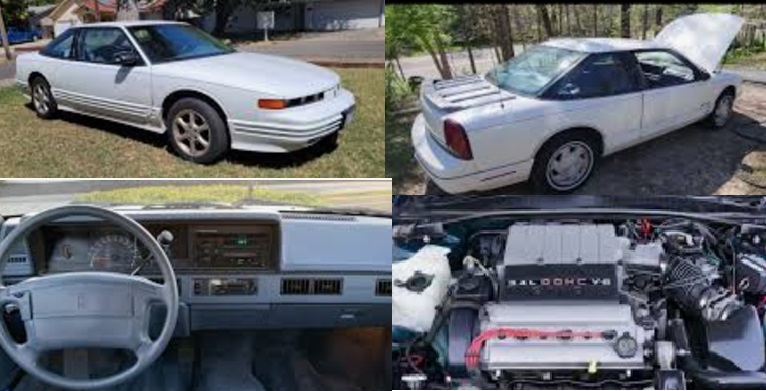 |
1995 Oldsmobile Cutlass | After the Taurus, Mom and Dad decided to make a big change, moving away from Ford and Mercury vehicles, which they had loyally owned since the late 1960s. This time, they chose a General Motors car—the Oldsmobile Cutlass. True to Mom’s favorite, the car was white, an ideal choice for the Florida sun. White not only looked elegant but also helped keep the car cooler in the intense heat—a practical decision in a place where leaving a darker-colored car outside could turn it into an oven. This Cutlass stood out with its wraparound glass near the rear C pillars, a design detail that gave it a distinctive look. The front was equally unique, featuring narrow, side-by-side turning signals, headlights that were sleeker than typical designs of the time. It was a modern, stylish car that marked a new chapter in their automotive journey, perfectly suited to their Florida lifestyle. |
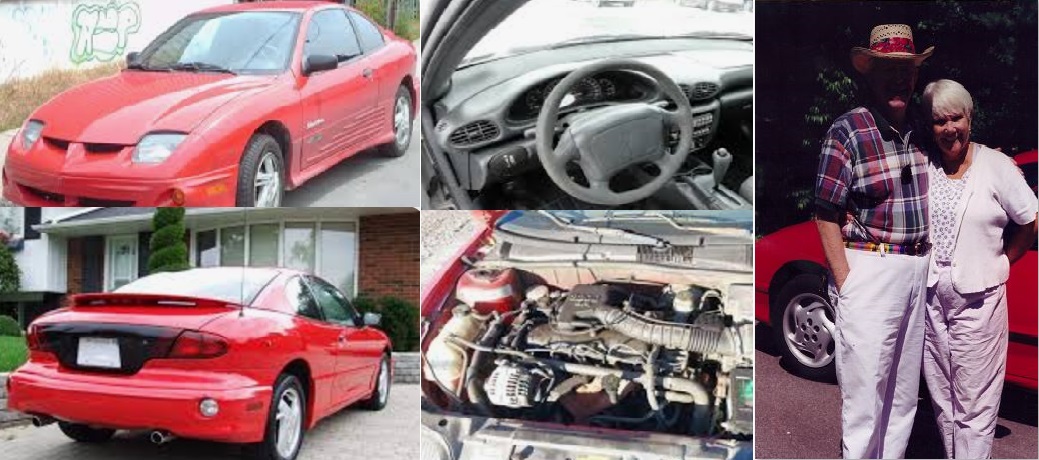 |
2000 Pontiac Sunfire | Mom and Dad’s next car broke away from their tradition of larger vehicles, embracing something smaller, sportier, and undeniably fun—a bright red, two-door Pontiac Sunfire. This car stood out with its unique, almost playful front headlights, as if it were looking at the world with a cheerful smile. Unlike Mom’s usual choice of white, the bold red color added a dash of excitement to their driveway. While it didn’t offer much in terms of cargo space, its compact size likely made it a breeze to drive and park, and its sporty nature promised an economical and enjoyable ride. |
 |
2003 Pontiac Grand Am | After downsizing with smaller cars, Peter and Nancy decided it was time for something bigger and more practical for family trips and long drives north. They chose a four-door Pontiac Grand Am, a comfortable sedan that offered the space and reliability they needed for their frequent journeys. The Grand Am quickly became a staple for family travel. Ed fondly recalls a memorable trip when he and Doreen went on a cruise to celebrate her 40th birthday. During this time, Peter and Nancy drove up in their Grand Am to watch Stephen and Eric, stepping in as caregivers while Ed and Doreen enjoyed their getaway. That same visit coincided with the family attending an Army vs. USF football game—a lively event that added excitement to their time together. The Pontiac Grand Am proved itself to be a dependable and spacious companion, ready to accommodate both family adventures and everyday life. For Peter and Nancy, the Grand Am wasn’t just a car; it was a vehicle that helped keep the family connected, no matter the distance. |
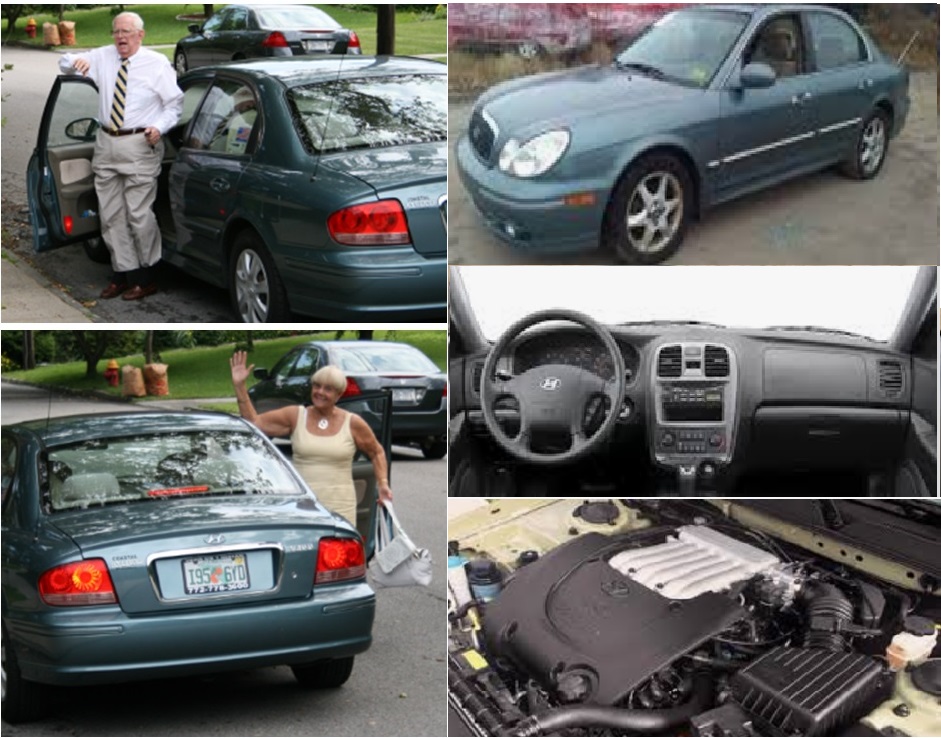 |
2005 Hyundai Sonata | Peter and Nancy’s next car was a significant shift from their usual American car choices: an aqua Hyundai Sonata that Peter instantly fell in love with. The sleek design, smooth handling, and modern features made it stand out, and Peter was proud to show it off to everyone. One memorable trip with the Sonata was a drive from Florida to Maryland for Thanksgiving at Maryhelen’s house. The car performed flawlessly on the journey, and Peter couldn’t contain his excitement. Upon arriving, he brought Ed outside to admire it, going over every inch of the car with pride. He explained how quiet and smooth the drive had been and marveled at all the options and features it came with. The Hyundai Sonata wasn’t just a car—it was a symbol of Peter and Nancy embracing something new and enjoying the journey, both on the road and in life. |
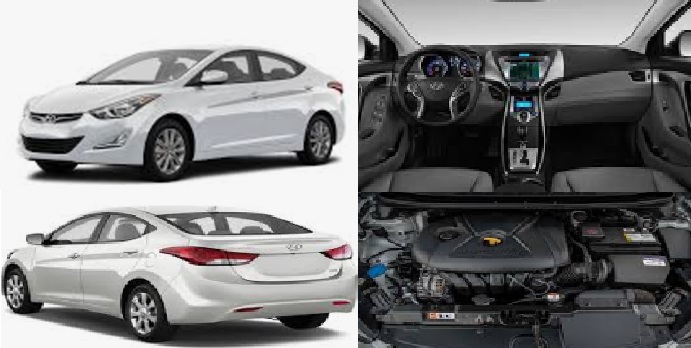 |
2014 Hyundai Elantra | When the Sonata started to show its age, Nancy decided it was time for an upgrade. Always resourceful, she handled the entire process herself, trading in the Sonata and driving away with a sleek white Hyundai Elantra—her favorite color. Nancy was particularly thrilled with the Elantra’s modern features, especially the backup camera, which made navigating tight spots and tricky parking situations a breeze. She drove the car proudly, enjoying the perfect blend of style, practicality, and independence it represented. The Elantra wasn’t just a new car—it was a testament to Nancy’s self-sufficiency and her ability to embrace the changes that make life a little easier and more enjoyable. |
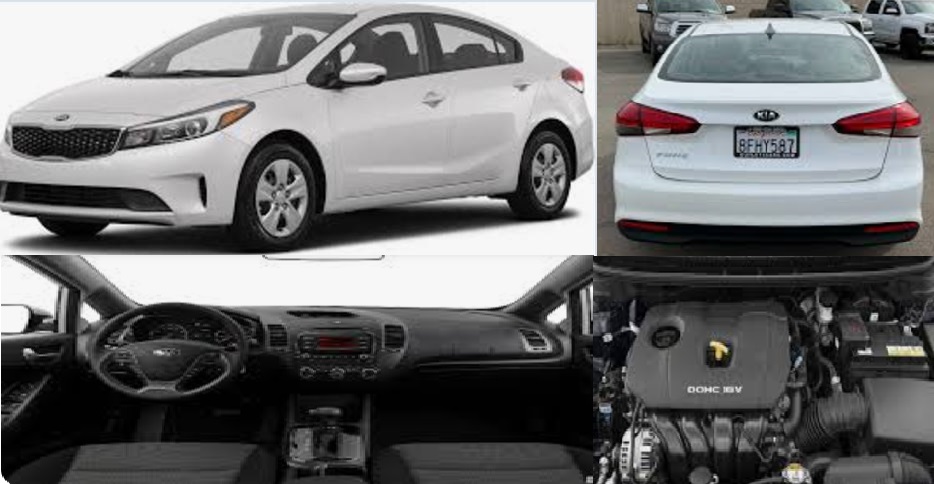 |
2017 Kia Forte | Nancy, Ed, and Eric set out to get Nancy a new car and ended up at a Kia dealership, where they found the perfect fit: a sleek, white 2017 Kia Forte. After some negotiation, they were able to make a deal that worked for everyone, with a reasonable lease payment and just a few dollars down. Nancy drove the Forte proudly, enjoying its reliability and comfort. After a few years of leasing, she decided to buy out the lease, making the car fully her own. The Forte became a trusted companion, serving Nancy well through its years of ownership. Recently, in the summer of 2024, the car found a new home when Dorothy bought it, continuing the Forte’s legacy within the family. This little Kia has been more than just a car—it’s been a part of the family’s journey. |
Others cars
| Make & Model | Story | |
|---|---|---|
 |
1986 Ford Escort | In the late 1980s, Dorothy bought her first car—a 1980s Ford Escort—and took on the challenge of teaching herself how to drive a five-speed manual transmission. It wasn’t easy at first, but with determination, she mastered the skill, turning her Escort into a reliable companion during an important chapter of her life. Dorothy used the Escort for years, driving it both in New York and later in Florida. The car served her well, offering practicality and independence as she navigated her early adulthood. It was with her through countless milestones and adventures, remaining a constant presence until she eventually married and started a family. The Escort wasn’t just a first car; it was a symbol of Dorothy’s resourcefulness and determination, a vehicle that carried her through years of change and growth, proving that sometimes the first car leaves the biggest impact. |
 |
2005 MAzda RX8 | Here’s a polished version of Stephanie’s Mazda RX-8 story: One day, after a cheerleading event, Stephanie and I were walking back to our car when she spotted a bright red Mazda RX-8 in the parking lot. She was only 12 at the time, but she instantly fell in love with the car’s sleek, sporty design. As we walked past it, she declared that one day she would own one. Years later, while visiting Cara for a ceremony, we stopped by a Mazda dealership. Once again, Stephanie laid eyes on the RX-8, and her dream of owning one was reignited. From that moment, she was determined to make it happen. Stephanie worked tirelessly to save for her dream car. Through jobs at White Plains Community in Florida, Jersey Mike’s sandwich shop, and as a hostess at Applebee’s, she managed to save over $6,000. Her dedication and hard work finally paid off when, as a junior at UCF, she purchased a dazzling blue 2005 Mazda RX-8. Owning the RX-8 was a dream come true for Stephanie. It wasn’t just about the car—it was about the journey, the hard work, and the determination that led her to it. The RX-8 wasn’t just a vehicle; it was a symbol of her ambition, independence, and the fulfillment of a goal she’d held onto since she was 12 years old. This version highlights Stephanie’s journey and determination, making the story as much about her character as it is about the car. Let me know if there’s anything else to include! |
 |
2016 Kia Soul | During her college years, Stephanie truly enjoyed driving her sporty Mazda RX-8. However, on a long drive home, she realized just how expensive and inefficient it was on gas. As much as she loved the car, she knew it was time for something more practical. With the help of her mom and dad, Stephanie traded in the RX-8 for a brand-new Kia Soul—a car famously advertised with those dancing rodents. For $16,000, she got an incredible deal on a car that was modern, practical, and fun in its own way. The Kia Soul came equipped with electric windows and the ability to connect her phone to the radio—a big upgrade in functionality. Its roomy interior and smooth ride made it the perfect car for the next phase of Stephanie’s life. The Soul quickly proved its worth. One memorable trip was when Stephanie drove with her parents, Ed and Doreen, to the University of West Virginia to move Eric into college. The car had plenty of space for the three of them and their luggage, handling the journey with ease. Over the next eight years, the Kia Soul became a reliable companion, taking Stephanie from Florida to Tennessee, to upstate New York, Asheville, Tennessee, and finally to Salt Lake City. After years of faithful service and countless miles, it was finally time to retire the Kia Soul shortly after Covid. Even then, the car held its value, and Stephanie managed to get an amazing deal when she sold it. The Kia Soul was more than just a car—it was a dependable partner that carried her through some of the most important chapters of her life. | 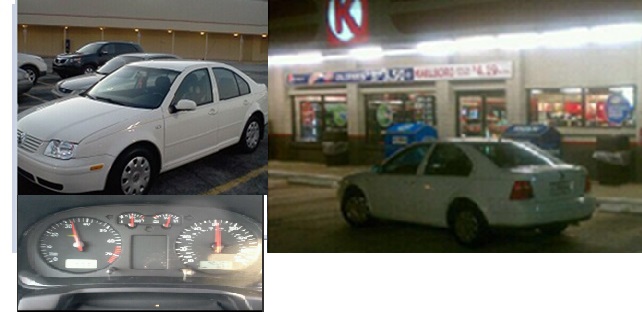 |
Jon’s first car was a Volkswagen Jetta, and for him, it was nothing short of life-changing. While attending Embry-Riddle, the Jetta symbolized more than just a vehicle—it was independence on four wheels. Gone were the days of relying on others for rides, pedaling a bike to class, or walking under the hot sun. This was freedom, plain and simple. The Jetta wasn’t just practical; it was perfect for a student’s lifestyle. It had plenty of room for Jon’s friends, his gear, and whatever else college life threw his way. Its fuel efficiency made it ideal for a student budget, and it had enough pep to keep things fun, whether he was navigating campus or taking road trips with his buddies. For Jon, the Jetta wasn’t just a car—it was the key to a new chapter of independence and adventure. |  |
Jayde had a scare when she was in an accident, but thankfully, she walked away unhurt. While the experience was unsettling, it marked the beginning of a new chapter—time for a new set of wheels. Enter the Hyundai Kona. The Kona was the perfect fit for Jayde. Compact yet versatile, it was as stylish as it was practical. With modern safety features, great gas mileage, and just the right amount of tech to keep things fun, it felt like a car made for her. Whether zipping around town or heading out on longer drives, the Kona offered the perfect blend of reliability and personality. After the accident, it wasn’t just about having a car—it was about having the right car, and the Kona delivered. |  |
Jayde had a scare when she was in an accident, but thankfully, she walked away unhurt. While the experience was unsettling, it marked the beginning of a new chapter—time for a new set of wheels. Enter the Hyundai Kona. The Kona was the perfect fit for Jayde. Compact yet versatile, it was as stylish as it was practical. With modern safety features, great gas mileage, and just the right amount of tech to keep things fun, it felt like a car made for her. Whether zipping around town or heading out on longer drives, the Kona offered the perfect blend of reliability and personality. After the accident, it wasn’t just about having a car—it was about having the right car, and the Kona delivered. |
Paul and Helen
| Make & Model | Story | |
|---|---|---|
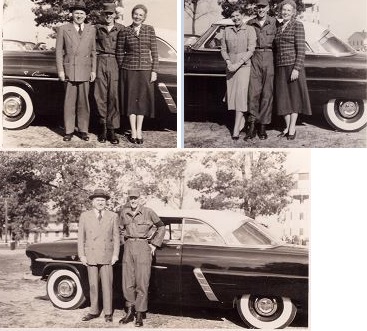 |
1952 Ford Crestline Victoria | Paul and Helen, now with Peter fully grown, decided to treat themselves to something truly special—a 1952 Ford Crestline Victoria. As the top trim level in Ford’s lineup that year, the Crestline Victoria was the epitome of postwar style and sophistication. Its sleek two-door hardtop design and chrome accents made it stand out as one of the most elegant cars on the road. Under the hood, the car featured a 239 cu in Flathead V8, producing 110 horsepower. This engine wasn’t just about power; it represented reliability and smooth performance, perfect for everything from Sunday drives to daily errands. The Crestline Victoria was more than just a car for Paul and Helen—it was a symbol of their hard work and the rewards of a life well lived. Stylish, comfortable, and a joy to drive, it quickly became a cherished part of their family's story. |
 |
1962 Mecury Comet | As the 1960s rolled in, so did a wave of change that swept across America, and Paul and Helen were right in the thick of it. Their next car marked a significant departure from the classic models they had grown accustomed to. Enter the compact car—a revolutionary design that was smaller, sleeker, and more efficient than anything they had driven before. Gone were the days of extravagant chrome and flashy fins that defined the automotive landscape of the 1950s. The compact car was a symbol of the times, embodying a shift towards practicality and fuel efficiency. Paul and Helen embraced this new era with open arms, excited to experience the benefits of a vehicle that was not only easier to drive but also kinder to their wallets at the gas pump. This compact marvel was perfect for navigating the bustling streets and tight parking spots of the growing suburbs. It was a car that reflected the changing values of the decade—less about ostentation and more about functionality. |
 |
1968 Mecury Montego MX | Paul and Helen’s next car was a real beauty—a 1968 Mercury Montego MX. It stood out with its sleek design and powerful performance. Ed fondly remembered the slanted dashboard, which featured a radiant background color to the dashboard that seemed to glow, giving the interior a modern and unique feel for its time. Another memorable detail was the distinct blinker sound, a small but characteristic touch that left a lasting impression. This car marked a significant milestone, as it would be the last top-of-the-line vehicle Paul and Helen owned. Powered by a 302 V8 engine, the Montego MX had plenty of pep, delivering a smooth and powerful ride. It was a joy to drive before the era of emissions regulations began to sap the performance of vehicles like this one. In later years, the car became a bit of a challenge for Paul and Helen, especially when it came to parking in their garage. The tight turn required to navigate the driveway into the garage made it tricky to maneuver such a sizable car. Despite these challenges, the 1968 Mercury Montego MX held a special place in their family history—a testament to style, power, and fond memories. |
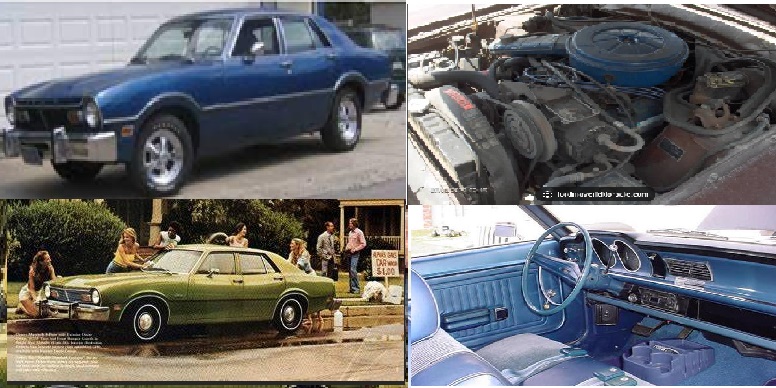 |
1976 Maverick | As Paul and Helen grew older, their choice in cars became more practical and modest. Their last car was a 1976 Ford Maverick in the base trim—far from the luxurious models they had owned in the past. This Maverick was as simple as it got: no radio, no frills, just air conditioning for comfort. Its dark blue paint and half hubcaps gave it a no-nonsense appearance, a stark contrast to their previous cars. Ed recalled borrowing the Maverick with a friend to take it for a drive down Spring Brook Parkway, a stretch of road known for its long, straight lanes. What made the experience amusing was the reaction of other drivers. The Maverick, with its plain, utilitarian look, resembled an unmarked police car. Drivers ahead of them would slow down or cautiously pull aside, thinking they were being followed by law enforcement. Though it lacked the luxury and performance of earlier cars in Paul and Helen’s lives, the Maverick served its purpose faithfully, embodying practicality and simplicity in their later years. It also left behind some lighthearted memories, a testament to how even the most basic car can carry stories and smiles. |
Donald and Dorothy
| Make & Model | Story | |
|---|---|---|
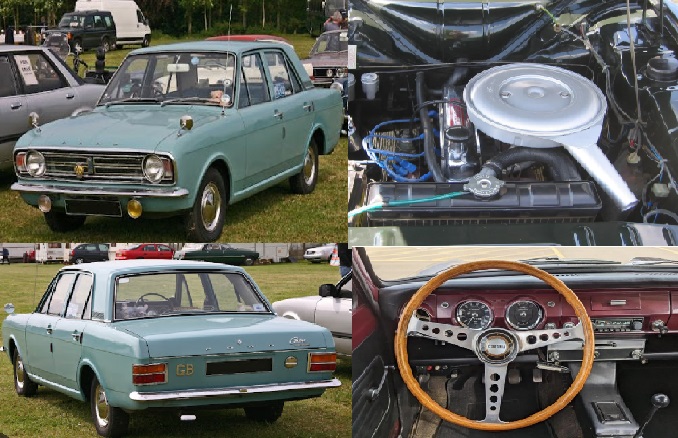 |
1966 Ford Cortina Mark II | |
 |
1971 Chevrolet Vega Station Wagoon | |
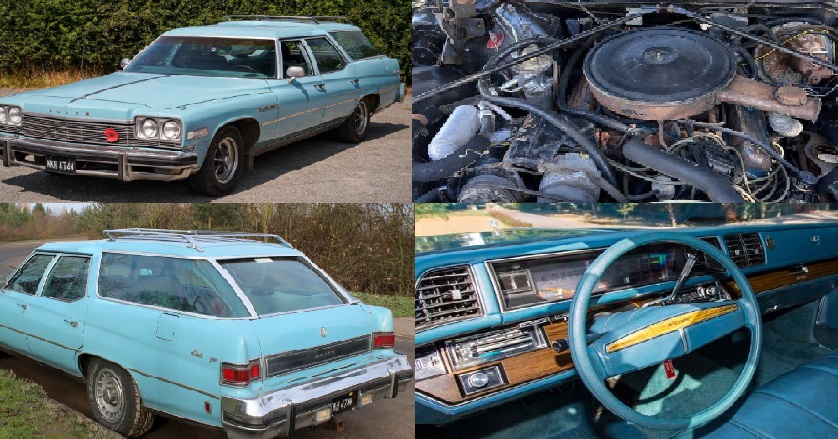 |
1975 Buick Wagon | |
Pete's cars
| Make & Model | Story | |
|---|---|---|
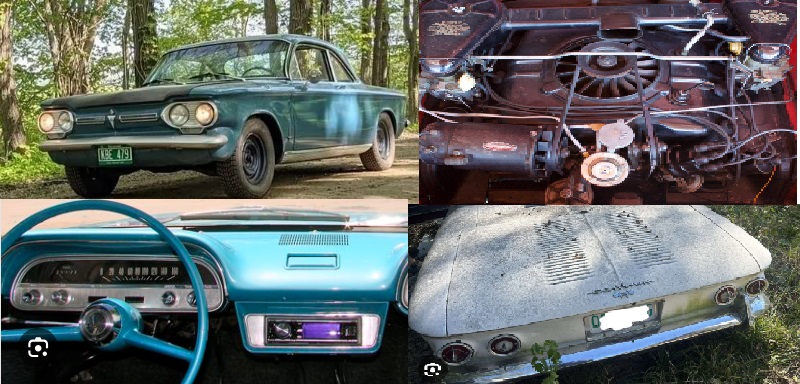 |
1963 Chevrolet Corvair | One day, my mom came home from work with exciting news: one of her coworkers knew of a 1963 Corvette for sale. Before she could even finish her sentence, Dad, Pete, Steve, and Ed were already out the door, eager to see this legendary car. But to their dismay, when they arrived, it wasn’t a Corvette at all—it was a Corvair. The initial disappointment quickly turned into excitement when Pete saw the low price tag. He was thrilled at the chance to get his hands on a car of his own, so we came home with the Corvair that day. While it wasn’t what they had expected, it quickly became a source of both adventure and frustration for the family. The memories of that car are plentiful, even if it was far from perfect. Pete brought a family friend Roy Fields a mechanic, hoping to solve its quirks, but no matter how hard they tried, the Corvair just couldn’t be fixed. It stubbornly refused to go over 30 miles per hour. Pete had to strategically avoid hills on his drives, as the car would just have enough power to go up hills. And as for Ralph Nader’s infamous critique of the Corvair in Unsafe at Any Speed? That definitely wasn’t referring to this particular car—it wasn’t going fast enough to be unsafe at all! |
 |
1969 Pontiac Grand Prix Model J | About a year later, my mom casually mentioned that she knew of a nurse who was selling a car. Despite their last experience, Pete cautiously listened, and once again, the four Garst men set out to take a look. This time, the trip paid off. The car turned out to be an incredible 1969 Pontiac Grand Prix Model J, a masterpiece designed by none other than John DeLorean, the legendary car guru. While the car didn’t have the best paint job, it more than made up for it with its luxurious and innovative interior. The cabin was designed like an aircraft cockpit, wrapping around the driver with all the controls and gauges perfectly positioned for ease and style. It was a car that made you feel in command the moment you sat behind the wheel. Under the hood was a beast of an engine: a 400 cubic inch V8 that roared to life at the slightest touch of the gas pedal. The power and performance were thrilling, and it was clear that this car was something special. Unlike the previous Corvair misadventure this car was true American muscle car. |
 |
1971 Pontiac Grand Prix Model J | After Pete had spent time working at Gurneys, tired of riding bikes and hitching rides, he finally had a little money in his pocket and decided it was time to look for a car. One day, Ed came home with some news: a coworker was selling a 1971 Pontiac Grand Prix. Pete, having fond memories of the 1969 Grand Prix he had once owned, jumped at the opportunity and bought the car. The 1971 Grand Prix served Pete well for a while, but its story came to a dramatic and unfortunate end. One day, Pete was out getting a rebuilt carburetor for the car. Meanwhile, my his dad decided he wanted to grab a pack of cigarettes. He went to start the car, but something went horribly wrong—the car immediately caught on fire. When Pete returned, all he could see was the aftermath: a large black mark on the ground where the car had been parked. The fire department had already put out the flames, but the Grand Prix was beyond saving. It became one of those family stories no one ever forgot—equal parts tragic and unbelievable. |
 |
1976 Maverick | After the tragic demise of the 1971 Grand Prix (may it rest in pieces), Dad and Pete struck a deal: Pete would take grandpa’s Ford Maverick off their hands. With grandpa in a nursing home and grandma having passed away, the Maverick wasn’t exactly seeing a lot of action. At the time, it seemed like a perfectly practical solution—at least on paper. Fast forward to the next chapter: Mom and Dad moved to Florida, and Pete was back living in the city. But there was one small hitch—the Maverick didn’t have a garage to call home, and Pete didn’t have a valid license to drive it. Practicality quickly went out the window, and the Maverick ended up...well, let’s say it was “left to fend for itself.” Out of sight, out of mind, right? Dad thought so, at least—until the mail arrived. One day, he opened an envelope from Yonkers and discovered tickets for an “abandoned vehicle.” Turns out, the Maverick had been unceremoniously left near Walt Whitman Junior High School for so long that it had become a local landmark—or maybe just an eyesore. This unexpected twist turned into one of the family’s most laughable car tales. Who knew a practical plan involving a hand-me-down car could spiral into tickets, abandoned-vehicle notices, and a Maverick with an urban legend-worthy ending? Moral of the story? Sometimes the road to practicality is littered with parking tickets—and a whole lot of laughs. |
 |
2003 Honda Accord Coupe | For a while, Pete didn’t have his own car because he lived in the city, where owning a vehicle wasn’t always practical. After moving in with Kitty they shared her Nissan Altima, which suited their needs. However, as they moved to New Jersey and the both worked in the city, it became clear that Pete needed a car of his own. Pete’s choice was a 2003 Honda Accord Coupe in a sleek black finish, equipped with a powerful V6 engine. It was a fantastic purchase, blending style, performance, and practicality. The 2003 model year introduced a fresh redesign for the Accord, giving it a sportier and more modern look. The car delivered excellent gas mileage, making it ideal for Pete’s frequent drives, while the V6 engine provided plenty of power for effortless acceleration. |
 |
1998 Volvo V70 Wagon | Pete’s next car marked a significant departure from his previous sporty and performance-focused vehicles. He opted for a Volvo station wagon, a practical choice that fit perfectly with the next stage of his life. During this time, Pete was spending much of his time skiing in Maine and working in upstate New York. The Volvo station wagon proved to be an ideal companion for these activities. Its spacious interior allowed him to easily carry his skis, gear, and other necessities, while its legendary Volvo reliability ensured he could tackle long trips and harsh winter conditions with confidence. The car’s rugged build and dependable performance made it perfect for navigating the snowy roads of Maine and upstate New York. Whether it was winding through snowy mountain passes to reach a ski resort or making the trek back home after a long workweek, the Volvo station wagon delivered the comfort and reliability Pete needed for this phase of his life. It wasn’t flashy, but it was a car that met his needs and supported his active lifestyle. |
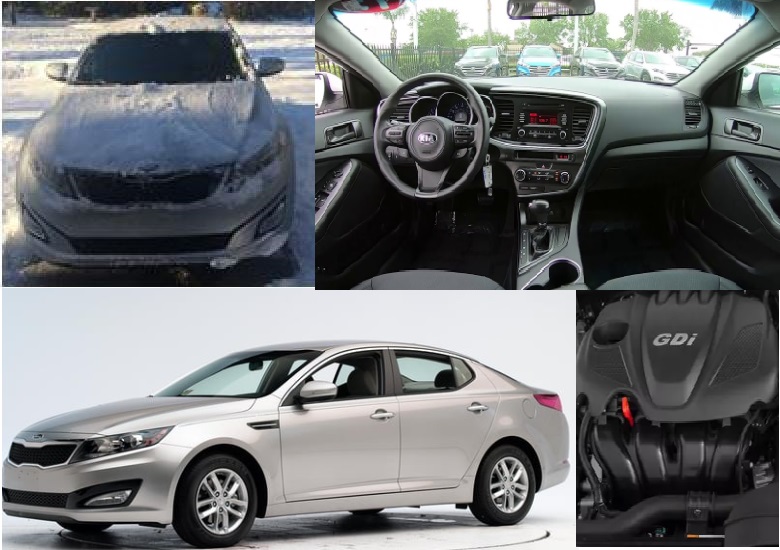 |
2015 Kia Optima | As Pete’s Volvo station wagon neared its 18th birthday, its age and wear became increasingly evident. It was time for an upgrade, and Pete decided on a late-model Kia Optima. While it wasn’t as spacious as the Volvo, the Optima offered a more modern and luxurious experience, with advanced features and refined styling. One of the highlights was its new turbocharged engine, which provided a smooth and powerful drive—perfect for Pete’s needs at the time. Unfortunately, what started as an exciting transition to a newer car took a devastating turn. The engine unexpectedly failed, and to make matters worse, Pete was unable to get the issue resolved under Kia’s warranty program. This left him without a reliable vehicle during a particularly challenging period in his life, as he was already navigating difficulties with work and health. The situation was both frustrating and disheartening, marking a difficult chapter for Pete. Despite the promise of the newer car, the experience served as a reminder of the unpredictability of life, even with the best intentions and plans. |
 |
2016 VW Jetta | After COVID and spending a little over a year living with Mom, Pete made a fresh start by moving back to the Jersey Shore. He returned to his work in the culinary industry, rekindling his passion for being a chef. After some time saving money, Pete treated himself to a late-model Volkswagen Jetta—a car that marked the beginning of a new, adventurous chapter in his life. The Jetta turned out to be a perfect fit for Pete’s lifestyle. It was reliable, comfortable, and efficient, but most importantly, it gave him the freedom to travel and explore the country. With his newfound independence, Pete embarked on memorable road trips, driving the Jetta to Detroit for basketball games, New Orleans for Jazz Fest, and even California for the Pebble Beach Golf Tournament. The Jetta became more than just a mode of transportation—it was a vessel for new experiences and adventures, symbolizing Pete’s resilience and his commitment to enjoying life to the fullest. Whether cruising along highways or navigating city streets, the Jetta was there for every mile of his exciting journeys. |
Others cars
| Make & Model | Story | |
|---|---|---|
 |
1986 Ford Escort | In the late 1980s, Dorothy bought her first car—a 1980s Ford Escort—and took on the challenge of teaching herself how to drive a five-speed manual transmission. It wasn’t easy at first, but with determination, she mastered the skill, turning her Escort into a reliable companion during an important chapter of her life. Dorothy used the Escort for years, driving it both in New York and later in Florida. The car served her well, offering practicality and independence as she navigated her early adulthood. It was with her through countless milestones and adventures, remaining a constant presence until she eventually married and started a family. The Escort wasn’t just a first car; it was a symbol of Dorothy’s resourcefulness and determination, a vehicle that carried her through years of change and growth, proving that sometimes the first car leaves the biggest impact. |
 |
2005 MAzda RX8 | Here’s a polished version of Stephanie’s Mazda RX-8 story: One day, after a cheerleading event, Stephanie and I were walking back to our car when she spotted a bright red Mazda RX-8 in the parking lot. She was only 12 at the time, but she instantly fell in love with the car’s sleek, sporty design. As we walked past it, she declared that one day she would own one. Years later, while visiting Cara for a ceremony, we stopped by a Mazda dealership. Once again, Stephanie laid eyes on the RX-8, and her dream of owning one was reignited. From that moment, she was determined to make it happen. Stephanie worked tirelessly to save for her dream car. Through jobs at White Plains Community in Florida, Jersey Mike’s sandwich shop, and as a hostess at Applebee’s, she managed to save over $6,000. Her dedication and hard work finally paid off when, as a junior at UCF, she purchased a dazzling blue 2005 Mazda RX-8. Owning the RX-8 was a dream come true for Stephanie. It wasn’t just about the car—it was about the journey, the hard work, and the determination that led her to it. The RX-8 wasn’t just a vehicle; it was a symbol of her ambition, independence, and the fulfillment of a goal she’d held onto since she was 12 years old. This version highlights Stephanie’s journey and determination, making the story as much about her character as it is about the car. Let me know if there’s anything else to include! |
 |
2016 Kia Soul | During her college years, Stephanie truly enjoyed driving her sporty Mazda RX-8. However, on a long drive home, she realized just how expensive and inefficient it was on gas. As much as she loved the car, she knew it was time for something more practical. With the help of her mom and dad, Stephanie traded in the RX-8 for a brand-new Kia Soul—a car famously advertised with those dancing rodents. For $16,000, she got an incredible deal on a car that was modern, practical, and fun in its own way. The Kia Soul came equipped with electric windows and the ability to connect her phone to the radio—a big upgrade in functionality. Its roomy interior and smooth ride made it the perfect car for the next phase of Stephanie’s life. The Soul quickly proved its worth. One memorable trip was when Stephanie drove with her parents, Ed and Doreen, to the University of West Virginia to move Eric into college. The car had plenty of space for the three of them and their luggage, handling the journey with ease. Over the next eight years, the Kia Soul became a reliable companion, taking Stephanie from Florida to Tennessee, to upstate New York, Asheville, Tennessee, and finally to Salt Lake City. After years of faithful service and countless miles, it was finally time to retire the Kia Soul shortly after Covid. Even then, the car held its value, and Stephanie managed to get an amazing deal when she sold it. The Kia Soul was more than just a car—it was a dependable partner that carried her through some of the most important chapters of her life. |  |
Jon’s first car was a Volkswagen Jetta, and for him, it was nothing short of life-changing. While attending Embry-Riddle, the Jetta symbolized more than just a vehicle—it was independence on four wheels. Gone were the days of relying on others for rides, pedaling a bike to class, or walking under the hot sun. This was freedom, plain and simple. The Jetta wasn’t just practical; it was perfect for a student’s lifestyle. It had plenty of room for Jon’s friends, his gear, and whatever else college life threw his way. Its fuel efficiency made it ideal for a student budget, and it had enough pep to keep things fun, whether he was navigating campus or taking road trips with his buddies. For Jon, the Jetta wasn’t just a car—it was the key to a new chapter of independence and adventure. |  |
Jayde had a scare when she was in an accident, but thankfully, she walked away unhurt. While the experience was unsettling, it marked the beginning of a new chapter—time for a new set of wheels. Enter the Hyundai Kona. The Kona was the perfect fit for Jayde. Compact yet versatile, it was as stylish as it was practical. With modern safety features, great gas mileage, and just the right amount of tech to keep things fun, it felt like a car made for her. Whether zipping around town or heading out on longer drives, the Kona offered the perfect blend of reliability and personality. After the accident, it wasn’t just about having a car—it was about having the right car, and the Kona delivered. |  |
Jayde had a scare when she was in an accident, but thankfully, she walked away unhurt. While the experience was unsettling, it marked the beginning of a new chapter—time for a new set of wheels. Enter the Hyundai Kona. The Kona was the perfect fit for Jayde. Compact yet versatile, it was as stylish as it was practical. With modern safety features, great gas mileage, and just the right amount of tech to keep things fun, it felt like a car made for her. Whether zipping around town or heading out on longer drives, the Kona offered the perfect blend of reliability and personality. After the accident, it wasn’t just about having a car—it was about having the right car, and the Kona delivered. |
MaryHelen's cars
| Make & Model | Story | |
|---|---|---|
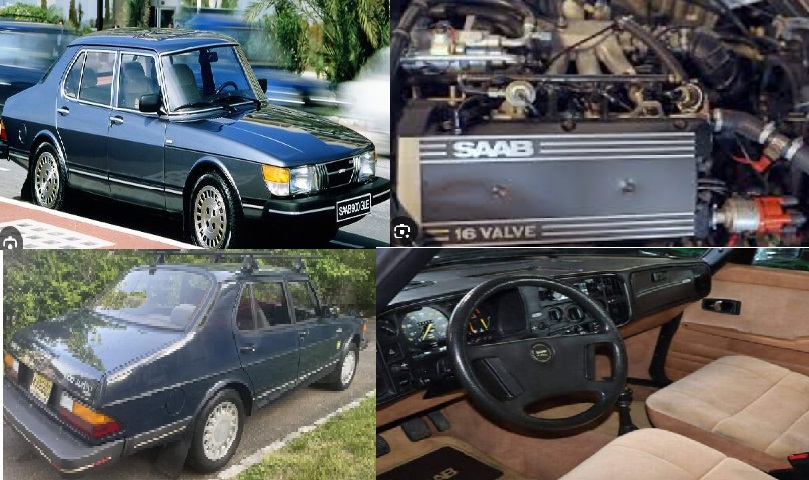 |
1982 Saab 900 4dr | MaryHelen’s first car was a true standout—a European luxury vehicle, the Swedish Saab 900. It was a thoughtful and exciting graduation gift from Roy, who surprised her with it right after the ceremony. Overnight, MaryHelen went from being a passenger to confidently navigating the roads in a manual 5-speed turbocharged car. At the time, not many people in America were familiar with Saabs, making the 900 even more unique. Its sleek Scandinavian design, combined with the thrilling turbocharged engine, made it a joy to drive. Learning to master the manual transmission added to the adventure, and it wasn’t long before MaryHelen fully embraced the Saab's quirks and charm. The Saab 900 wasn’t just a car—it was an introduction to independence, responsibility, and the thrill of driving something extraordinary. It set the tone for her early driving experiences and left her with memories of a car that was as special as the moment she received it. |
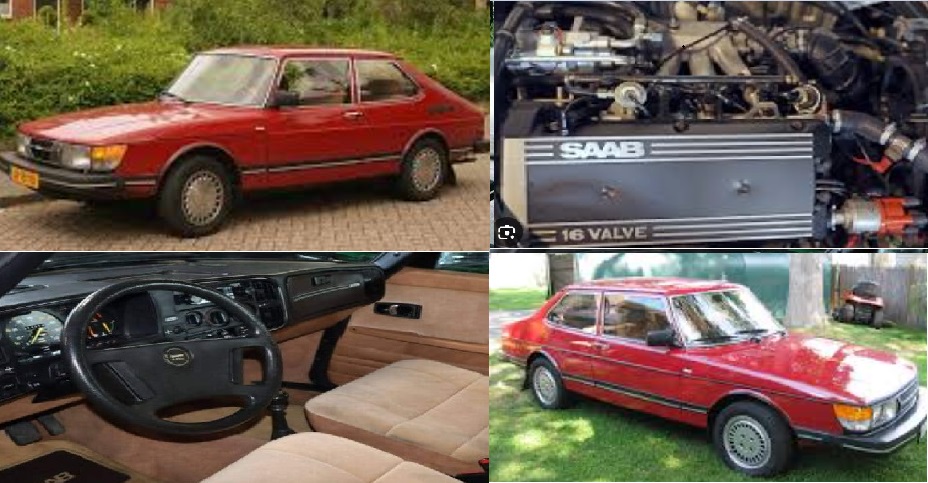 |
1983 Saab 900 2dr |